অচেনা ভিয়েতনাম – প্রথম অধ্যায়
@Asim Deb
This book is dedicated to those brave Heroes of Vietnam who fought not for many years, but for decades after decades to save their motherland against invasions and interferences by the Japanese, by the French, by the Americans.
The country was devastated till mid ‘70s by the Americans. So, the series of 4 articles are dedicated to those who are the architects to todays’ Vietnam, building it again from the ashes. And not the least, I dedicate my book to those guerrilla heroes who taught the world how to fight a war of independence, against the world’s richest and most powerful nation.
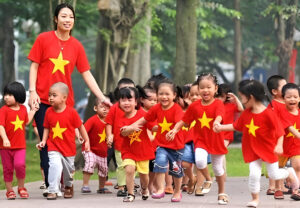
About the book
The people of Germany and Japan had to rebuild their nation, as they surrendered after the shameful devastating end of the second World War in 1945. In Vietnam too, people had to rebuild their nation, though devastated but not as a consequence of loss, rather that of a glorious victory in their struggle for independence against the United States of America in 1975.
In the last century, Vietnam has primarily been in the news for their guerrilla wars, fighting against the world’s richest and most powerful nation. Amidst this, much has been left unknown about the country, most remarkably about their success in establishing their identity as one of the most progressive countries of the world in the last 50 years.
The people of Vietnam exhibit great pride in preserving their ancient heritages: for example:
** The Temple of Literature dated 1070 AD, dedicated to the great philosopher Confucious,
** Chua Tran Quoc Pagoda dated 548 AD,
** Ha Long Bay, with 1600+ limestone hills in the mid sea, and many of theose having caves as old as 10,000 years,
** Bát Tràng Ceramic Village dated 1010 AD,
** One Pillar Pagoda dated 1049 AD,
** Hanoi Silver Market, 500 years old,
** Cu Chi Tunnel trench, that spans over 75 miles and was used as a shelter and hiding spot for the guerrillas during the war.
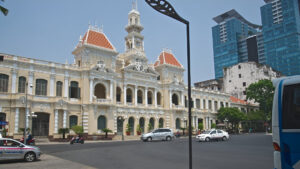
The list would be too long for this small sized country. Despite being hit by the tragedies of war, all the landmarks of Vietnamese heritage have been restored, along with institutions like old Pagodas, Churches, Indo-French and Indo-Gothic architectural buildings like offices, opera houses, museums, and also heritage hotels. What attracts is the co existence of both heritage and modern buildings, in adjacent areas.
During our father’s recent visit to Vietnam, he had the opportunity to learn more about their ancient history and heritage, struggle for independence, and evolving international relations, that have created a unique position for the country on the global map. Speaking to the local people, he also got a glimpse of their social and cultural habits, and religious faith. In his article, he tried to curate his experiences to share more about Vietnam, and with this I hope to enlighten his wonderful readers about this beautiful country.
Thanks,
Chandrika and Priyanka (Daughter)
********
লেখকের নিবেদন
প্রথমেই স্বীকার করি, আমি সম্প্রতি ভিয়েতনাম গিয়েছিলাম, কিন্তু যাওয়ার খুব একটা উৎসাহ ছিলো না। ভিয়েতনাম নিয়ে সোশ্যাল মিডিয়ায় খুব একটা গুণগান দেখি না যতটা সিঙ্গাপুর, থাইল্যান্ড, কম্বোডিয়া এরকম এশিয়ান দেশ নিয়ে দেখি। কিন্তু ভিয়েতনাম গিয়ে আমার ধারণাটাই বদলে গেলো। যে দেশ ১৯৭৫ সালে স্বাধীনতা পেয়ে ধ্বংসস্তূপ থেকে উঠে এসেছে, সেই দেশই অর্থনৈতিক উন্নতিতে এখন সারা দুনিয়ায় আলোড়ন তুলেছে। এগুলো সাধারণ লোকে জানে না।
ভিয়েতনাম সমরাস্ত্রে অত্যন্ত দুর্বল একটি দেশ যাঁদের দীর্ঘিদিন ধরে বহিঃশত্রুর আগ্রাসন থেকে নিজেদের মাতৃভূমিকে রক্ষা করতে হয়েছিল। আমরা শুধু জানি যে মার্কিন যুক্তরাষ্ট্রের বিরুদ্ধে ঐতিহাসিক জয় (১৯৭৫), কিন্তু জানি না যে এর আগেও জাপান (১৯৪০), তারপর ফ্রান্স (১৯৪৬), এর আগেও ফ্রান্স (১৮৫৮-১৮৮৫), ও চীনের আধিপত্য রুখতেও তাঁরা যুদ্ধ করেছিল। বাইরের প্ররোচনায় ১৯৭৫ সালের স্বাধীনতার পরেও আরও ১৪ বছর কম্বোডিয়ার বিরুদ্ধে যুদ্ধ (১৯৭৮- ১৯৯১)। পৃথিবীর ইতিহাসে এরকম দ্বিতীয় উদাহরণ নেই। সায়গন শহরে War Remnants Museum দেখলে এর কিছুটা ধারণা পাওয়া যাবে।

আমি ভিয়েতনাম গিয়ে তার ইতিহাস, স্বাধীনতা যুদ্ধ, রাজনৈতিক পরিবর্তন, এবং ঐতিহ্যময় স্থাপত্য দেখে এই বইতে আমার অভিজ্ঞতার কিছু লিখেছি। বর্ননা করেছি, যেমন ১৪০০ বছরের পুরনো বিশ্ববিদ্যালয় (১০৭০ সালে নির্মিত), স্বাধীনতা যুদ্ধের সময় গেরিলাদের তৈরি ২৫০ কিলোমিটার বিস্তৃত দোতলা সুরঙ্গ, One Pillar Pagoda (১০৪৯ সালে নির্মিত), Lake of the Restored Sword (১৪২৪ সালে নির্মিত), হ্যানয় সিলভার মার্কেট (৫০০ বছরের পুরনো), আর আছে বহু ইউরোপিয়ন স্থাপত্যের দৃষ্টিনন্দন নিদর্শন যেমন সেন্ট্রাল পোস্ট অফিস, নোতর দাম চার্চ, অপেরা হাউস, অনেকগুলি মিউজিয়াম যেখানে ১০০ থেকে ১০০০ বছরের নিদর্শন সংরক্ষিত আছে। আছে ইন্দো-চিন স্থাপত্যের দর্শনীয় সব প্যাগোডা। হ্যানয় ট্রেন স্ট্রীট, Tết Festival, ফ্লাওয়ার মার্কেট, সেরামিক ভিলেজ, মেকং ডেল্টা, ইত্যাদিরও যথাসম্ভব উল্লেখ করেছি। আর আছে সমুদ্রের মাঝে ১৬০০ পাহাড়ি দ্বীপপুঞ্জ নিয়ে Ha Long Bay, কিছু দ্বীপে আছে ১০,০০০ বছরের পুরনো গুহা।
আমি আমার “অচেনা ভিয়েতনাম” বইয়ের মাধ্যমে পাঠকদের জানাতে চাই যে, এই দেশটি সত্যিই আমাদের অজানা, ভিয়েতনাম নিয়ে অনেক কিছুই আমাদের জানার আছে। আশা রাখি, পাঠকদের এই বইটি ভালো লাগবে একটা কথা, এখন বাংলা বানানে অনেক নতুন চিন্তাভাবনা এসেছে। এই বইতে আকাদেমি বানান অভিধান অনুসরণ করা হয়েছে।
Acknowledgement:
Internet sites of History.com;
Vietnam Tourism,
History of Vietnam,
Britannica,
Wikipedia,
and few photographs available in internet.
Also, thanks for our good friend Dipayan Lodh, who has made this wonderful cover design.

অচেনা ভিয়েতনাম প্রথম পর্ব
স্কুলে সেভেন এইটে নাইনের সময়ের কথা, ৬৮-৬৯-৭০ ঐসময়ে কলকাতার দেয়ালে দেয়ালে লাল কালিতে দুই পার্টির দেয়াল লিখন দেখতাম। একদল লেখেন তোমার নাম আমার নাম, ভিয়েতনাম, ভিয়েতনাম। আবার লেখেন ভুলতে পারি বাপের নাম, ভুলবো নাকো ভিয়েতনাম। তখন অন্যরা লেখেন চীনের চেয়ারম্যান আমাদের চেয়ারম্যান। দ্বিতীয় দলের কথা সহজেই বুঝি, যে একদল আদি চীন দেশের লোক। স্বদেশ, মাতৃভূমি, আত্মীয় পরিজন, সবকিছু ত্যাগ করে আমাদের ভারতবর্ষে এসে দীর্ঘদিন ধরে বসবাস করেন। স্বভাবতই তাঁরা চীনের চেয়ারম্যনকে নিজেদের চেয়ারম্যান ভাবেন।
কিন্তু প্রথম দলের ব্যাপারটা কোনদিনই বুঝিনি। কি এমন ব্যাপার যে হঠাৎ করে আমার নাম হয়ে যাবে ভিয়েতনাম? কেন? আমার বাপ-মায়ের দেওয়া নামটা তোমাদের পছন্দ নয়? তার সাথে আমার বাপের নামটাও ভুলে যাবো? তখনই কৌতুহলবশত জানলাম যে ভিয়েতনাম নাকি একটা দেশ। স্কুলের ইতিহাসে আমি যে ভিয়েতনাম পড়িনি সে দস্তুর মনে আছে, কিন্তু সুধীর মাষ্টারমশাই ভূগোলের ক্লাসে এই দেশ পড়িয়েছিলেন কিনা, আজ আর মনে পড়ে না। (অর্ধশতাব্দী আগের সিলেবাস, এখন আর মনে নেই)। আরও একটা ধাঁধা। ভিয়েতনামে মার্কিন কালো হাত ভাঙ্গার জন্য কলকাতার ধর্মতলার রাজপথ জ্যাম করে বাস-ট্রাম ট্যাক্সি কেন বন্ধ হবে? কোন এক মার্কিনী ম্যাকনামারা সাহেব কলকাতায় এলেন, আর এনারা কলকাতার সরকারী ট্রাম বাস পুড়িয়ে দিলেন? এসব তো কিছুতেই মাথায় ঢোকে না। তখন যেসব লোকেরা বড় গলায় বলতেন যে “আমার নাম ভিয়েতনাম”, বা কালো হাত ভেঙে দেওয়ার জন্য রাস্তা জ্যাম করে ট্রামবাসের যাতায়াত বন্ধ করে দিলেন, বা সরকারী বাসে আগুন ধরিয়ে দিলেন, আজও সেই লোকগুলি আমার সেই দিনের সেই প্রশ্নগুলোর উত্তর দিতে পারেন না। এরপরে কলেজে গিয়ে এর ওর থেকে ভিয়েতনাম নিয়ে খানিকটা শুনি। তখন গুগল নেই। সত্য মিথ্যা যাচাই করারও উপায় নেই। বিশ্বাসে মিলায়ে বস্তু।
এবার মাসখানেক আগে আমাদের বাড়িতে আলোচনা হয়, এবার কোথায় বেড়াতে যাই? শোনা গেল যে আজকাল অনেকেই নাকি ভিয়েতনাম ভ্রমণে যায়, তাহলে চলো আমরাও যাই। শুনেই আমার প্রশ্ন। পয়সা খরচ করে পরিবারসহ লালদুর্গের দেশে গিয়ে সর্বহারাদের দেখতে যাবো? রাস্তা জ্যাম করা মিছিল, আর “জোট বাঁধো তৈরি হও” গণসঙ্গীত? তখন সকলেই বলে, আরে না বাবা, একদমই নয়। আমি প্রস্তরযুগের ব্যাকডেটেড, কিছুই খবর রাখি না। ভিয়েতনাম এখন শুধু নামেই কমিউনিস্ট, শুধুই কাগজে কলমে। কমিউনিজম নাকি ওঁরা গঙ্গার জলে, না না, মেকং আর সায়গন নদীর জলে বিসর্জন দিয়ে এখন পুরো ক্যাপিটালিস্ট দেশ। ভিয়েতনামের লোকজন নাকি এখন কালো হাতওয়ালা মার্কিনীদের সাথে প্রচুর বানিজ্য করে। আর কালো হাতগুলো যে ওনারা এখনও ভাঙ্গছেন, এমন খবরও তো টিভি বা খবরের কাগজে পড়ি না!!
অল্পবিদ্যায় গুগল ঘাঁটাঘাঁটি করে যেটুকু বুঝলাম, আপাতত ভিয়েতনামের কমিউনিস্ট পার্টি CPV দেশটিকে শাসন করে। জনগনের এইখানে নাক গলানোর কোন অধিকার নেই, যদিও জনগনই শক্তির উৎস। এই কমিউনিস্ট পার্টির নেতারা নিজেরাই নিজেদের রাজা উজির বানায়, আর অন্যান্য রাজনৈতিক ধ্যানধারণার লোকেরা ঘরে বসে আঙ্গুল চোষে, কারণ তোমাদের কার্যকলাপ এখানে নিষিদ্ধ। এই নিষিদ্ধের তালিকায় আছে কোনো ভাষণ সভা সমাবেশ ইত্যাদি চলবে না, ধর্ম ও সংবাদ যা হবে সব সরকারের পছন্দমতন (freedom of association, freedom of speech, freedom of religion, and freedom of the press)। তুমি বিক্ষুব্ধ হতে পারবে না, হলেই সরকারের থাবা। ২০০৯ সালে এখানের আইনজীবী Lê Công Định কে capital crime of subversion এর দায়ে গ্রেপ্তার করলে Amnesty International এনাকে এবং সহকর্মীদের prisoners of conscience আখ্যা দেয়।
একদিকে সাধারণ লোকজন আর অন্যদিকে সরকারি পার্টির লোকজন, কেউ একে অন্যকে ঘাঁটায় না। ঘাঁটালেই সমস্যা। তাই শান্তিপূর্ণ সহাবস্থান। সুতরাং কমিউনিজম এখন কোথায় গিয়ে পৌছালো সেটা দেখারও একটা আগ্রহ নিয়ে ভিয়েতনাম যাওয়া যেতেই পারে। অনেক চিন্তা করে রাজিই হলাম।
সিঙ্গাপুর চাঙ্গি এয়ারপোর্ট থেকে ভিয়েতজেট বিমানের দু ঘন্টার সফর শেষে যখন সায়গন এয়ারপোর্টে (IATA: SGN) নামি, তখন হো চি মিন শহরের সময় বেলা আড়াইটা। আগে এই শহরের নাম ছিলো সায়গন, এখন হো চি মিন। সব ফ্লাইটই জমি থেকে আকাশে উঠার সময় বিমানসেবিকারা তাঁদের শারীরিক মুদ্রার নানান কায়দায় স্বাগতম দেখায়। তুমি সিগারেট খাবে না, অক্সিজেন কমে গেলে কি করবে, এমার্জেন্সিতে কি করবো ইত্যাদি, ইত্যাদি অনেক কিছুই বোঝায়। আরে কন্যা, বিপদের সময় অত কি লোকের মনে থাকে? তবু এই কন্যারা রোজ একই কথা বলে, একই মুদ্রা দেখায়। কিন্তু যা উল্লেখযোগ্য, এই কন্যারা শেষে আমাদের একটা স্যালুট দিলেন। এয়ার ইন্ডিয়ার নমস্কার আমার দেখা, অন্যান্য বিদেশী বিমানে শুধু হ্যালো ছাড়া অন্যকিছুর বালাই নেই, কিন্তু এই স্যালুটের ব্যাপারটা আমার কাছে নতুন লাগলো। তারপর সায়গনে বিমান অবতরন করলে মাইক্রোফোনে আরেকদফা ধন্যবাদসহ “আবার হবে তো দেখা, এ দেখাই শেষ দেখা নয়” বলার পরে আবার সেই স্যালুট। বাঃ, বেশ নতুন তো!! কন্যারাও বেশ স্মার্ট, পড়নে টাইট লাল টিশার্ট,আর হাঁটুর একহাত উপরে হাফপ্যান্ট। মাথায় মিলিটারি কায়দার এক টুপি। সর্বদা মুখে হাসি। ভাবি কখন আরেকটা স্যালুট দেবে?


বিমানের পাইলটরা সব বিদেশী, অন্যান্য কর্মীরা স্থানীয় ভিয়েতনামের। বছর কয়েক আগে এই ভিয়েতজেট বিমানের নাম ছিলো বিকিনি এয়ারলাইন্স। এই বিমানসেবিকারা বিকিনিবসনে সজ্জিতা হয়ে মাঝআকাশে আমাদের মতন সাধারণ লোকজনদের পরিষেবা দিতেন। গুগল নেট ছাড়া আমার সেসব ছবি দেখার সুযোগই হয় নি। পরে খোঁজ নিয়ে জানলাম সেই বিশেষ খাতির বহুদিন আগেই ইতিহাসের পাতায় বিদায় নিয়েছেন। এখন শুধুই ঐ টাইট লাল টিশার্ট,আর হাঁটুর একহাত উপরে হাফপ্যান্ট।

কন্যাগুলি বেশ চটপটে। ফ্লাইটে ওঠামাত্র বিনা দরকারেই জানতে চায়, মে আই হেল্প ইউ? ইউর সীট নাম্বার প্লিজ? হাতের ব্যাগ নিজেই মাথার উপরের চেম্বারে রেখে দেয়। প্লেন চালু হলে ট্রেতে ডজনখানেক চায়ের কাপ নিয়ে আসে, “স্যার, উড ইউ লাইক টি ওর কফি?” এঁদের দেখে, সহযাত্রীদের দেখে তো একেবারেই সর্বহারা মনে হয় না।
ভিয়েতনামের অর্থনীতিতে ট্যুরিজম এখন অন্যতম প্রধান আন্তর্জাতিক বানিজ্য। সেইদিক দিয়ে চিন্তা করলে এখানের এয়ারপোর্ট সেরকম আহামরি কিছু নয়, আধুনিক সুযোগসুবিধার অনেক খামতি আছে। ২০০৭ সালে জাপানি অর্থসাহায্যে (Official Development Assistance) চারটি কন্ট্রাক্টরের কনসরটিয়াম KTOM (Kajima, Taisei, Odayashi, আর Maeda) এই এয়ারপোর্ট তৈরির কাজ শুরু করে। ২০১৪ সালে যাত্রীসংখ্যা বেড়ে হয় প্রায় ৯০ লাখ, তখন আরও দুটি নতুন জেট ব্রিজ ছাড়াও টার্মিনালের সম্প্রসারণ এবং আরও কিছু নতুন সুবিধা যোগ হয়, ফলে এই টার্মিনাল এখন বছরে প্রায় সোয়া কোটি যাত্রীর পরিষেবা দেয়, তবে যেটুকু দেখলাম, আমার মতে আন্তর্জাতিক ট্যুরিজমের জন্য এখানে আরও উন্নত মানের সুযোগসুবিধা হওয়া উচিৎ। এবং শুনলাম ভিয়েতনাম সরকার আরও বিদেশী বিনিয়োগ ও বিদেশী ট্যুরিস্টদের জন্য কিছু সম্প্রসারণ পরিকল্পনা করে রেখেছে।
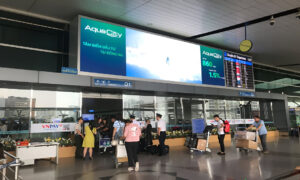
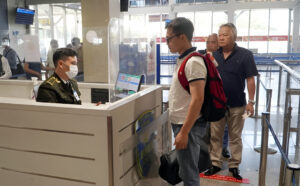
ইমিগ্রেশনে আন্তর্জাতিক যাত্রীদের জন্য এঁরা যথেষ্ট যত্নবান। ডেস্কে বসা প্রত্যেকের গায়ে মিলিটারিদের মতন ইউনিফর্ম। সঙ্গে বন্দুক নেই তো? ভাষার সমস্যা আছে জানি। গন্ডগোল হলে, বা আমাকে অপছন্দ হলে এঁদের ইংরেজি ভাষাও তো বুঝবো না। লাইনে দাঁড়ানো প্রচুর বিদেশী, কিন্তু ইমিগ্রেশন ডেস্কে বসা সামান্য কয়েকজনই ইংরেজি ভাষা জানেন, সকলে নয়, তাহলে? দেখি, এনারা হাতের ইশারায় বুঝিয়ে দেন কি করণীয়। আমাদের ছিলো ই-ভিসা (e-Visa), পাসপোর্টে ভিসা স্ট্যাম্প ছিলো না। ভদ্রলোকের মুখে মাস্ক, আমাদের পাসপোর্টে স্ট্যাম্প দিয়ে হাতের ইশারায় বুঝিয়ে দিলেন, আমাদের সব ঠিক আছে, এবার আগে বড়ো। ভয় ছিলো কোভিডের সার্টিফিকেট নিয়ে ইমিগ্রেশনের দ্বাররক্ষী কর্তারা যদি প্রশ্ন করেন? (২০২১ সালে কোভিডের প্রকোপ অনেকটাই কমে যাওয়ার পরে এনারাও নিয়মকানুন শিথিল করে দিয়েছেন)।
ইমিগ্রেশন পেরিয়ে লাউঞ্জে এসে প্রথমেই যা নজরে আসে, এক, চারিদিকে সব মঙ্গোলিয়ান মুখশ্রী, আর দুই, সবাই ফর্সা ধবধবে। সকলেই বেশ চটপটে, চতুর্দিকে মানুষের কিচির মিচির আওয়াজ। ভালো করে কান পেতে শুনলে এক একটা কথায় মনে হয় দশ দশটা চন্দ্রবিন্দু। যেমন আমাদের হোটেলের ঠিকানা 3C Đ. Tôn Đức Thắng, এবার উচ্চারন করুন।
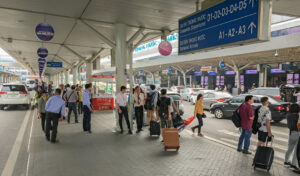
আসার আগে গুগলে একটা সাবধানবানী দেখেছিলাম
(Airport Arrival Tips), Be aware of pickpockets, elbowing, and shoving when you leave airport terminal
(https://www.itourvn.com/blog/airport-arrival-tips-at-tan-son-nhat-international-airport-ho-chi-minh-city).
কলকাতার মেট্রোর বা বাসের ভীড়ে পকেটমারি হয়, রেল ষ্টেশনের প্ল্যাটফর্মে ধাক্কাধাক্কি ছিনতাই হয়, তাই বলে ইন্টারন্যাশনাল এয়ারপোর্টে Elbowing, and Shoving? কি জানি, অচেনা মহল্লা। দেশের সরকার নিজেই যদি আমাকে সাবধান করে তখন আমাদের সাবধান হওয়াই উচিৎ। চলো, আগে বড়ো।
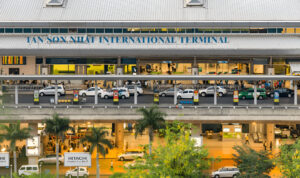
মালপত্র ছাড়িয়ে এয়ারপোর্টের বাইরে ট্যাক্সির স্ট্যান্ডে এসে দেখি বেশ গরম, আন্দাজ প্রায় ৩৫-৩৬ ডিগ্রীর মতন। হলকা না হলেও ঘামে অস্থির। মেয়ে GRAB ট্যাক্সি ডাকলো। গ্র্যাব মানে আমাদের ওলা উবেরের মতন। জিপিএস দেখালো যে ট্যাক্সি মাত্র ৫০ মিটার দূরে। কিন্তু তখন সেখানে এত প্যাসেঞ্জার আর কেউ ট্রাফিক নিয়ম মানে না, তাই সেই ৫০ মিটার আসতেই ট্যাক্সি সময় নিলো প্রায় মিনিট পনের। ট্যাক্সি ড্রাইভারের নাম বনং। সঠিক উচ্চারণ করতে পারবো না। দেখলাম ছোট ছোট কথায় মোটামুটি কাজ চালানোর ইংরেজি বলে। আমি যেচে ভাব জমানোর চেস্টা করলাম। সে নিজে থেকেই প্রশ্ন করে, “ইনদিয়া?” বলি হ্যাঁ। “ও, বিউতিফুল কানত্রি।“
এয়ারপোর্টের বাইরে কিছু লাল পতাকা, কিছু জায়গায় হো চি মিন সাহেবের ছবি। গতকাল ছিলো পয়লা মে, মানে আন্তর্জাতিক শ্রমিক দিবস। তাঁর আগের দিন ৩০শে এপ্রিল রিইউনিফিকেশন ডে। অনেক ভিয়েতনামী বলেন বিজয় দিবস Victory Day (Ngày Chiến thắng), কেউ বলেন মুক্তিদিবস Liberation Day (Ngày Giải phóng or Ngày Giải phóng miền Nam), অথবা সরকারিভাবে Day of the Liberation of the South and National Reunification (Ngày Giải phóng miền Nam, thống nhất đất nước)।
আমরা এখানে এলাম ১লা মে। ঐতিহাসিক দিক দিয়ে এই দিনটি এখানে গুরুত্বপূর্ণ। এর আগে ১৯৭৫ সালের ২৯শে এপ্রিল আমেরিকানরা এই দেশ থেকে সপরিবারে পালিয়ে যায়, মানে ঐতিহাসিক ১লা মে’র ঠিক দু’দিন আগে। এরপরই ভিয়েতনাম নিজেদের স্বাধীনতা ঘোষণা করে। বিজয় উৎসব হয় পরদিন ৩০শে এপ্রিল, এবং উত্তর-দক্ষিণ ভিয়েতনামের পুনরায় মিলন। সরকারীভাবে ভিয়েতনাম কমিউনিস্ট শাসিত দেশ, সুতরাং ধারণা ছিলো যে বিগত তিনদিনের রাজনৈতিক অনুষ্ঠান ও উদযাপনের কারণে চারদিক হবে লালে লাল। কিন্তু সেরকম কিছুই দেখলাম না। হোটেলে যাওয়ার পথে, ৮ কিলোমিটার রাস্তায় দু’চার জায়গায় আর পথের দু’পাশের কিছু বিল্ডিং এর গায়ে উড়ন্ত লাল পতাকা। ট্যাক্সি ড্রাইভার জানালো যে এগুলি সরকারী দপ্তর। আমার মনে হলো, গত দশ বছরে ভিয়েতনামে কয়েক লক্ষ কোটি ডলারের বিদেশী মুদ্রার আমদানী হয়েছে। তাই, প্রথমেই প্রশ্ন জাগে, ভিয়েতনাম বা সাধারণ লোকেরা এখন ভক্তিভরে কতটা কমিউনিস্ট?
হোটেলে আসার পথে শহরের শুরুতে পুরনো মহল্লায় দুপাশে পুরনো দিনের বাড়িঘর, কিন্তু বড়বাজার, কাশীপুর, দমদমের মতন অযত্ন নেই। পুরনো সায়গন শহরের রক্ষণাবেক্ষণের ব্যাপারে এনারা খুবই যত্নবান।


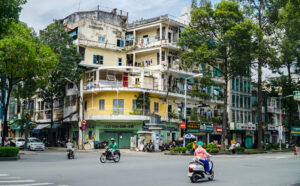
সুন্দর সুন্দর রাস্তা, ছোটখাটো ল্যান্ডস্কেপিং। এয়ারপোর্ট ছেড়ে যতই আগে শহরের দিকে চলি, ততই ইটের পাঁজরে লোহার খাঁচায় আধুনিকীকরনের ছাপ সুস্পষ্ট। এক এক করে সামনে আসে উচ্চ উচ্চ আধুনিক সব অট্টালিকা।
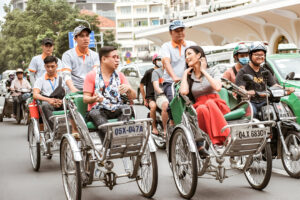
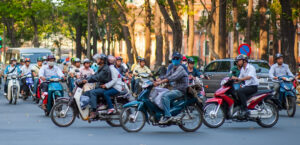
আর দেখি চারিদিকে ঝাঁকে ঝাঁকে মোটরসাইকেল, সকলের মুখে মাস্ক। আর ঝকঝকে বিদেশী গাড়ি, ফোর্ড, কিও, টয়োটা, হুন্ডাই। যতই দেখি, লোকজনের পোষাকে সর্বহারার কোন ছাপই নেই। আর দেখি অদ্ভুত এক ধরণের রিক্সা। ছবিতে আগে দেখেছি, এখন চাক্ষুষ দেখলাম। সামনে একজন মাত্র যাত্রী আরাম করে বসতে পারে, আর চালক থাকে পিছনে। দেখে মনে হয় ট্যুরিস্ট, তবে এই গরমে?
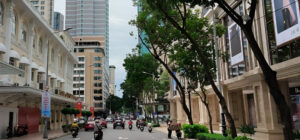

যতই শহরের কেন্দ্র, মানে ডিস্ট্রিক্ট ওয়ানের দিকে যাই, আধুনিক জীবনযাত্রার ছাপ স্পষ্ট, সে রাস্তার লোক হোক, বা রাস্তার চেহারা, বা দু’ধারে বাড়িঘর দোকানপাটের চেহারায়। সামনেই দেখি রাস্তার মোড়ে গ্র্যান্ড হোটেল। বাঃ, কলকাতার কথা মনে পড়ে গেলো।
এয়ারপোর্ট মূল শহরের সামান্য বাইরে। শহরের কেন্দ্রে (স্থানীয় লোকেরা বলে ডিস্ট্রিক্ট ওয়ান) যেতে লাগে মোটামুটি ২৫ মিনিট। এয়ারপোর্ট থেকে আমাদের মেরিডিয়ান হোটেল খুব একটা দূরে নয়, মাত্র পৌনে আট কিলোমিটার, সময় নিলো ২৫ মিনিট। মিটারে স্থানীয় মুদ্রায় কত পয়সা শুনলে আমার মতন নাদান লোকজন ভয়ই পাবে, এক লক্ষ ষাট হাজার ভিয়েতনামী ডলার (VND), তখন হিসেব করে দেখি আমাদের ভারতীয় মুদ্রায় ৫৭৬ টাকা। মানে সংখ্যাটা দেড় লাখ থেকে পাঁচ’শ টাকায় নেমে এলো, খানিক শান্তি পেলাম।
সায়গন নদীর ধারেই আমাদের ঠিকানা, লা মেরিডিয়ান হোটেল। আমরা যাকে বলি panoramic views, বেশ সুন্দর, সাথে ছোট একটা ল্যান্ডস্কেপিং। হোটেলের ঠিকানার উচ্চারণ আমাদের আসাধ্য। একজন ভিয়েতনামীকে আমি যদি বলি, ভায়া শুদ্ধভাবে পুণ্ডরীকাক্ষ বলো তো, তাহলে সেও আমাকে হোটেলের ঠিকানা উচ্চারণ করতে বলবে
3C Đ. Tôn Đức Thắng,
Bến Nghé, Quận 1, Thành phố
Hồ Chí Minh, Vietnam
এইসব Tôn Đức Thắng, Bến Nghé, Quận 1, Thành phố ইত্যাদি উচ্চারণের কেরামতির দরকার নেই, হোটেল মেরিডিয়ান বলাই সহজ। সাথে যদি হোটেলের কার্ড থাকে, ফুর্তিতে ঘোরাঘুরি করো, কোন চিন্তা নেই।
মেরিডিয়ান হোটেলের রিসেপশনটি বেশ সুন্দর, আধুনিক। রিসেপশনে মহিলা বলা যাবে না, কমবয়সী কন্যারা আছেন। সকলেরই লাল ইউনিফর্ম। মোটামুটি ইংরেজি বলেন। অভিধানের শব্দগুলি জানেন তবে ব্যাকরণের সমস্যা আছে। ইংরেজি বলা শিখেছেন, নেসফিল্ড সাহেবের গ্রামার বই মনে হয় অধ্যায়ন করেন নি। আমার প্রশ্ন বা বক্তব্য লম্বা হলেই ওনাদের সমস্যা। তাই ছোট ছোট বাক্য দিয়েই বোঝাই। এরপর উত্তরগুলিও চেষ্টা করে বুঝতে হয়। আমাদের চাটগাঁ, তামিল্ বা ভোজপুরী লোকেদের ইংরেজি বলায় যেমন নিজস্ব কিছু টান থাকে, সে এখানেও আছে, ভিয়েতনামী পেটেন্ট করা।
এবার বিশেষ করে আমার প্রধান চিন্তা যে এই ক’দিন খাবো কি? প্রতিবেশী ব্যাংকক, সিঙ্গাপুরে আমার খাওয়ার বেশ সমস্যা ছিলো। যদিও ছোটবেলা থেকেই শুনি যষ্মিন দেশে যদাচার, সেই যস্মিন দেশে আমার স্ত্রী-কন্যার কোন খাদ্যেই অরুচি নেই, কিন্তু আমার দ্বারা তো সেটি হবে না। আসার আগে স্কুলের বন্ধুবর সতীনাথ বলে, ভিয়েতনামের নুডুল স্যুপ খাবি, খুবই ভালো। আরে মিয়াঁ, আমি কলকাতার নুডল স্যুপই খাই না, তো রাখ তোর ভিয়েতনামী স্যুপ! রিসেপশনের কন্যা সুখবরটি দিলেন যে এই হোটেলে আছে latest recipe of global cuisines, আর চোখের সামনেই নাকি ওপেন কিচেন। আরে শিশুকন্যা, আমি তোর global cuisines আর ওপেন কিচেন নিয়ে করবো টা কি? তোর global cuisines এর কারখানায় কি ইন্ডিয়ান ফুড পাবো? আর যদি পাওয়াও যায়, সেটি যে কি পদের যে হবে, সে আমি আন্দাজ করতে পারি। বিপদের আশঙ্কায় আগেই ঠিক করা আছে, কিছু না পেলে আমি তিনবেলাই ব্রেড ওমলেট, বা কলা আপেল দিয়েই চালিয়ে দেবো। সতীনাথের ভিয়েতনামী নুডল স্যুপ কিছুতেই নয়।
কি মনে করে রিসেপশনের কন্যাটিকে প্রশ্ন করেই ফেললাম, এখানে ভারতীয় রেস্তোরাঁ আছে? তাজ্জব ব্যাপার, সে বলে দশ-বারো কিলোমিটারের মধ্যে প্রায় ডজন খানেক ভারতীয় রেস্তোরাঁ আছে। গুগল ঘেঁটে কয়েকটি নাম বলে দিলো যেমন নমস্তে ইন্ডিয়া, তন্দুর ইন্ডিয়া, বেনারস ইন্ডিয়া, গনেশ ইন্ডিয়া, তাজ ইন্ডিয়া, দালচিনি, নটরাজ, আরও আছে। নামগুলো শুনে মনে বড়ই শান্তি পেলাম, কিন্তু এইবার মুসকিল যে কোনটায় যাই? ভেবেছিলাম কিছুই পাবো না, এখন যে দেখি problem of plenty. রিসেপশনের কন্যাটি খবর দিলো, এই হোটেলের পাশেই নাকি ভালো ইন্ডিয়ান রেস্তোরাঁ আছে, দালচিনি। স্ত্রী-কন্যাকে সুখবরটি দিলে ওনারা দয়াপরবশ হয়ে রাজি হলেন যে আজ রাতে দালচিনি অভিযান হবে, কারণ ওনারা চাক্ষুষ করেছেন, গত তিনদিন সিঙ্গাপুরে আমার কি অসহায় অবস্থা হয়েছিলো।
এখন দুপুর শেষ হয়ে বিকেল হবে, বাইরে বেশ গরম, প্রায় ৩৫ ডিগ্রি।
আমার স্ত্রীকন্যা ইতিমধ্যেই খবর নিয়েছেন, এখানের নিউমার্কেট, গড়িয়াহাট, হাতিবাগান অঞ্চলগুলি কোথায়? আজ আর দর্শনীয় স্থানে যাওয়ার সময় নেই, তাই আজ বিকেলে আমাদের যাত্রা নিউমার্কেট, গড়িয়াহাট, হাতিবাগান দর্শনে। নিউমার্কেটের (Ben Thanh Market) দরজা নাকি সন্ধ্যা ছ’টায় বন্ধ হয়ে যায়। সুতরাং আজ সায়গন স্কোয়ার মার্কেট আভিযানে যাবো। মানে আমাদের গড়িয়াহাট, হাতিবাগান। হোটেলের রুমেই চা পর্ব সেরে নিয়ে বেলা প্রায় সাড়ে চারটের সময় ট্যাক্সি ডেকে স্ত্রীকন্যা গড়িয়াহাট, হাতিবাগানে রওয়ানা দিলেন। আমিও সঙ্গে।
রাস্তায় দেখলাম কিছু লাল পতাকা, কিছু কাস্তে হাতুড়ির পতাকা, আর কিছু আছে শুধুই তারা মার্কা পতাকা। মানে আলাদা আলাদা তিন রকমের। একই পতাকায় একসাথে কাস্তে হাতুড়ি তারা নেই। আমাদের বাংলায় তো লাল পতাকায় কাস্তে হাতুড়ি তারা এই তিনটেই থাকে। ভাবি প্রশ্ন করি, ভায়া তোমাদের নেই কেন? আবার মনে হয়, এই প্রশ্ন আমি ইংরাজিতে ট্যাক্সিওয়ালাকে কিভাবে বোঝাই? আর সেই বাঃ আমার প্রশ্ন কতটা বুঝবে? যাই হোক, যা দেখলাম, বিচ্ছিন্নভাবে রাস্তার দু’ধারে সব লাল পতাকা।
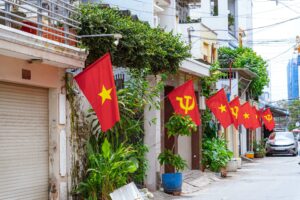
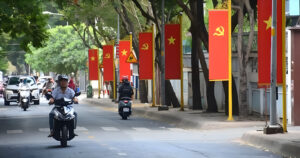
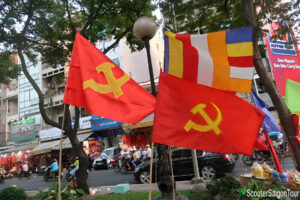
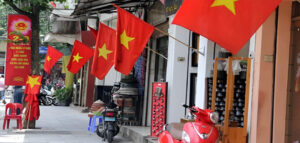
যা মনে হলো, গতকাল ছিলো মে দিবস, আন্তর্জাতিক শ্রমিক দিবস, সেইজন্য পথের বিভিন্ন জায়গায় ব্যানার ঝুলিয়ে CPV, মানে ভিয়েতনামের কমিউনিস্ট পার্টি, নিজেদের অস্তিত্ব সাধারণ জনগণকে মনে করিয়ে দিলেন। (পরে এব্যাপারে হোটেলের এক ইংরেজি জানা স্টাফ যা বললেন, তার সারমর্ম যে এনারা CPV-র লালা পতাকায় পাত্তাই দেয় না, এনারা নিজেদের মতন আছেন। আর ভিয়েতনামের কমিউনিস্ট নেতারাও সাধারণ লোকদের ঘাঁটাতে চায় না)। শান্তিপূর্ণ বোঝাবুঝি ও সহাবস্থান।
যদিও শহরের বর্তমান নাম হো চি মিন, তবে অধিকাংশ বিদেশীই সায়গন বলেন। যেমন সাহেবদের আরও কিছু সময় লাগবে আমাদের ক্যালকাটাকে কলকাতা বলার জন্য। এই সায়গন শহরটি আয়তনে খুবই ছোট। সবকটি গন্তব্যস্থলই কাছাকাছি। হোটেল থেকে ট্যাক্সি নিয়ে ডিস্ট্রিক্ট ওয়ানের রাস্তার দুধারে তাকিয়ে মনে হয় আমাদের পার্ক স্ট্রীট, লিন্ডসে স্ট্রীট, ক্যামাক স্ট্রীট, সেকস্পীয়র সরণী, রাসেল স্ট্রীট, লাউডন স্ট্রীট কলকাতার এইরকম সবকটি সাহেবপাড়া অঞ্চল যোগ করে একটি ক্ষেত্রফল। তবে কলকাতার তুলনায় অনেক ভালো করে সাজানো। দুইপাশের দোকানের লাইনেরও যেন শেষ নেই। তবে এখানে যতগুলি সারি সারি উচ্চ উচ্চ অট্টালিকা রাস্তার দুপাশে সদম্ভে দণ্ডায়মান, কলকাতার সাহেবপাড়ায় বা কোন পাড়াতেই সেটি নেই। এবং কলকাতার সাহেবপাড়ার তুলনায় অনেক পরিস্কার পরিচ্ছন্ন।
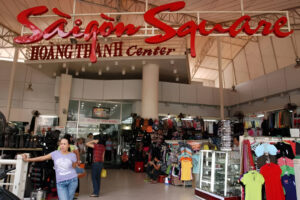
সায়গন স্কোয়ার এসে দেখি ব্যাস্ত মার্কেট। এখানেই সায়গন সেন্টার নামের সুউচ্চ শপিং অট্টালিকা, মানে মল, অল্প দামী বেশি দামী শৌখিন সামগ্রীর জায়গা। আর ঠিক উল্টোদিকেই একতলা সায়গন স্কোয়ার মার্কেট, যেখানে দোকানী আপনার কাছে দশ টাকা চাইলে আপনি লজ্জা বিসর্জন দিয়ে পাঁচ টাকা বলবেন। দরাদরি হবে, শেষে বোঝাপড়া করে কেনাকাটাও হবে।

সায়গন স্কোয়ারের মার্কেট একতলা এক ছাদের তলে সব ছোট ছোট দোকান, বড় দোকান একটাও নেই। আর মুখোমুখি সব দোকান, মাঝে বড় জোর ফুট পাঁচেক চওড়া চলার রাস্তা (সরু গলিই বলা ভালো)। দোকানের ভেতরে তো ঢোকার উপায় নেই, সেই সরু গলিপথেই দাঁড়িয়ে সবকিছু, মানে কেনাকাটা, দরাদরি, লেনদেন, ইন্সপেকশন (মানে কাপড়ে ছেঁড়া ফাটা কিনা চেক করা)। সরু আসাযাওয়ার পথে দুইপাশের দোকানে কয়েকজন ক্রেতা একই সময় দাঁড়ালে নিজেদের পশ্চাৎদেশে ঘর্ষনের ভালোই সম্ভাবনা আছে।

আমার স্ত্রী-কন্যা কিছু একটা কিনবেন, কিন্তু কি কিনবেন সে বিষয়ে স্থির কিছু নেই। এক দোকানে জামাকাপড় দেখেন, পরের দোকানে দেখেন ভ্যানিটি ব্যাগ, তারপরের দোকানে গিফট আইটেম। দোকানীরা তো ওয়েলকাম ম্যাডাম, ওয়েলকাম ম্যাডাম সুরে ডাকাডাকি করে। দুই তরফেই ইংরেজি ভাষার আদানপ্রদান, যদিও একজনের কথা অন্যজন সঠিক বোঝে না। আমি ভয়ে সামান্য দূরে দাঁড়িয়ে। আমার সামনে যদি ব্যাটাছেলেদের টিশার্টের দোকান, তো আমাকে সে টিশার্ট দেখায়। আমি মুখে হাসি এনে বলি, নো থ্যাঙ্কস। দোকানী মনে মনে নিশ্চয়ই বলে, তা বাপু কিনবে না যখন, তা আমার দোকানের সামনে ভীড় বাড়াও ক্যান? মনে মনে হয়তো নিশ্চয়ই গালি দেয়, লজ্জায় মুখে কিছু বলে না। স্ত্রী-কন্যা দোকানের সাজানো জিনিষগুলি দেখে, তারপরই “নো, থ্যাংক ইউ”। এই “নো, থ্যাংক ইউ” কথাটা এখানের ইংরেজি না জানা মূর্খ মানুষজনও বোঝে। প্রায় এক ঘন্টায় যত দোকানের যতরকমের সামগ্রী দেখা হলো, তাঁর ১০০ শতাংশই নো, থ্যাংক ইউ।
অবশেষে একটি দোকানের গিফট আইটেমগুলি আমার স্ত্রী-কন্যার পছন্দ হয়। নানান বৈচিত্র্যের মাঝে একটা ছোট্ট সুন্দর শো’পিস। পাঁচটা চাই। আমি বলি, পাঁচটা??? স্ত্রী হিসেব দেয় মণিমালা, নাগচম্পা, সুতৃপ্তিদি, বিষ্ণুপিয়া, সুরঞ্জনা। মিনিটখানেক পরেই না না, আরও একটা চাই নানী, নানী। সঙ্গে সঙ্গে না না, সাতটা চাই, সাতটা। তা এই সাত নম্বরটা কার জন্য? জানলাম, স্টকে থাকবে যদি ভবিষ্যাতে কোনদিন কোন একজনের নাম মনে পড়ে। আমার প্রশ্ন, আর যদি কোন নাম মনে না আসে? “স্টকে থাকবে।“ দোকানীর সাথে প্রথমে দরাদরি হয়েছিলো দু-তিনখানা নেবো, সেটা হলো পাঁচ, তারপর ছয়, তারপর সাত। সংখ্যা যতই বৃদ্ধি পায়, দরাদরিও ততই বাড়ে। অবশেষে সাতটি একই রকমের শো’পিস কিনে সগর্বে আমরা রওয়ানা দিলাম। একবার ভাবি বলি যে, সাত সাতটি উপহার তোমার সাতজন বান্ধবীর জন্য, আমার বন্ধুরা কি ফ্যালনা?
– “কেন? ওনাদের স্বামীরা কি তোমার বন্ধু নয়?”
কেনা হয়ে গেলো। কয়েকটি দোকানের পরে অন্য দোকানে দেখি হুবহু সেই একই জিনিষ। স্ত্রী-কন্যা ভাবেন, ইসসসসস, হয়তো এই দোকানের দাম আরও সস্তা হতো !!! পরের এক ঘন্টা শুধু মার্কেটের এই গলি আর ঐ গলি। প্রথম রাতে আর বেশি সওদা হলো না, মার্কেট স্টাডি করতেই ঘড়ির কাঁটা রাত আটটার ঘরে।
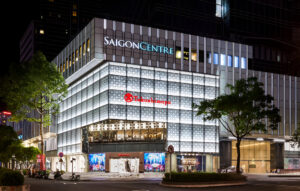
বাইরে এসে দেখি উল্টাদিকে সায়গন স্কোয়ার সেন্টারে লাইন দিয়ে গাড়ি ঢুকছে। অফিস ফেরতা পয়সাওয়ালা বাবুরা বা বিজনেস ট্যুরিস্টরা ব্রান্ডের জিনিষ কিনবেন। কেউ বা রাতের মোহময়ী রেস্তোরাঁয় যাবেন।
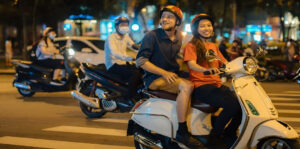

দেখলাম দু’চাকার ভেস্পা ট্যাক্সি আছে। ফোন করলেই চলে আসে। আবার অনেকেই নিজের স্কুটারে অন্যকে লিফট দেয়, পয়সা নিয়েই এই সার্ভিস যদিও অনেক চালকের সেই লাইসেন্স নেই। সেই স্কুটারের চালক ব্যাটাছেলে হতে পারেন, আবার সুন্দরী তরুণীও হতে পারেন। তিনি স্বচ্ছন্দে অপরচিত একজন পুরুষ সওয়ারি তুলে নেবেন, ভয়ের কিছু নেই। আমাদের দেখেই কেউ কেউ ডাকাডাকি করে, লিফত? লিফত? বলি, নো থ্যাঙ্ক ইউ।
এবার আমাদের গন্তব্যস্থল ভিয়েতনামের ভারতীয় রেস্তোরাঁ, নাম দালচিনি। মেয়ে GRAB ট্যাক্সি বুক করে দিলো। মানে আমাদের দেশের ওলা উবেরের মতনই এখানের স্থানীয় টেলিফোন ট্যাক্সি। আসার আগেই কয়েকজন বলে দিয়েছেন, মিটার ট্যাক্সি না নিয়ে যেন GRAB ট্যাক্সি নি, কারণ মিটার ট্যাক্সি এক টাকার রাস্তা শহর ঘুরিয়ে পাঁচ টাকা করে দেয়। GRAB ট্যাক্সি গোলমাল করে না, কারণ কম্পিউটারাইজড। GRAB ট্যাক্সিতে মিনিট দশেকের রাস্তা। দালচিনি রেস্তরাঁয় গিয়ে দেখি আরও কয়েকটি ভারতীয় পরিবার নিজেদের ভাষায় উচ্চনিনাদে গল্পে মশগুল। দূরের টেবিল থেকেও ওনাদের কথাবার্তা শোনা যায়। আর কিছু বিদেশীও আছেন, তাঁরা স্বভাবসিদ্ধ নিচু গলায় বার্তালাপ করছেন। রেস্তোরাঁর এক ভারতীয় কর্মচারী মেনু কার্ড দিলেন। আমাদের দেশীয় কাবাব, তন্দুরি, ভর্তা, কোপ্তা, মসালা চিকেন, বাসমতী চাল, নান, রুটি সবকিছুই আছে। আমার প্রিয় মেনু চিকেন তন্দুরি, চিকেন মসালা আর নান। স্ত্রী-কন্যারও তাই পছন্দ কিন্তু ভ্যারাইটির জন্য অন্যকিছুও নিলাম। স্বাদ? সব আদি ভারতীয় পাচকের হাতের ভারতীয় তেল ঘি মশলার ভারতীয় স্বাদ।
সেখানে একটা নতুন অভিজ্ঞতা। খাওয়ার পরে হাত মোছার জন্য টিস্যু পেপার চাইতেই সার্ভিস বয় একটা ট্রেতে হাতের আঙ্গুলের আংটির সাইজের এক সেন্টিমিটার মতন চওড়া, আর এক সেন্টিমিটার মতন ডায়ামিটার সাইজের কয়েকটা সাদা রোল দিয়ে গেলো। এটি কাগজ না কাপড় কিছুই বুঝলাম না। বহু টানা হেঁচড়া করেও আমরা কিছুতেই রোলগুলোকে খুলতে পারলাম না। রেস্তোরাঁর ছেলেটিকে ডাকতেই সে রোলগুলোকে আমাদেরই পাশে রাখা একটা ছোট্ট বাটিতে জলের মধ্যে ফেলে দিলো। আর আমরা সপরিবারে অবাক হয়ে দেখলাম যে রোলগুলো আস্তে আস্তে খুলে গিয়ে চওড়া হয়ে গেলো। আরে! এ তো নতুন এক প্রোডাক্ট নলেজ! আর তার ব্যাবহারের কায়দাও জানলাম।
এবার হোটেলে ফেরা। ট্যাক্সি নিতে হয়। রেস্তোরাঁর ভারতীয় ছেলেটিকে প্রশ্ন করলাম, ভায়া হোটেল মেরিডিয়ান কত দূরে? সে তো হেসেই ফেলে। মেরিডিয়ান? রেস্তোরাঁর দরজায় এসে দেখিয়ে দিলো, এই যে সামনের বিল্ডিং, এটাই হোটেল মেরিডিয়ান। অচেনা জায়গায় ঈশ্বর সহায়। ট্যাক্সি না করে আমাদের প্রায় পঁচিশ হাজার VND সাশ্রয় হলো। হাঁটাপথে মনে হলো হোটেল আন্দাজ পঞ্চাশ মিটার। রাস্তায় তখন সারি সারি মোটর সাইকেল আর বেশ কিছু গাড়ি। হোটেলের সামনেই সায়গন নদী। রুমে গিয়ে দেখি নদীর পাড় সুন্দরভাবে বাঁধানো, আর প্রচুর আলোয় সাজানো। দূর থেকেই বোঝা যায় যে নদীর পাড়ে প্রচুর লোকজন।

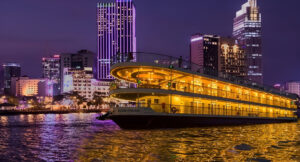
পরে একদিন রাতে সায়গন নদীর পাড়ে গিয়ে দেখেছি ভ্রমণের খুব ভালো ব্যাবস্থা আছে। একটু এগিয়ে গেলেই ছোট একটা জেটিতে বেশ কিছু ছোট বড় ক্রূজ বাঁধা। এনারা বলেন নাইট রিভার বাস। বড় ক্রূজে বিলাসের আয়োজন বেশি। আধুনিক চাহিদার সব ব্যাবস্থাই আছে। নিজের বাজেট বুঝেই লোকেরা ক্রূজ চড়ে। যদি নদীতে সফর করতে ইচ্ছা না হয়, তবে জেটিতে বা সায়গন নদীর পাড়ে উদ্দেশ্যবিহীন হয়ে বসে থাকার জন্যও প্রচুর বসার জায়গা। ওপেন রেস্তোরাঁ, বার, ফাস্ট ফুড, আইসক্রীম পার্লার, মনোরঞ্জনের মোটামুটি চাহিদার বস্তুগুলি সবই আছে। আপনার সঙ্গী বা সঙ্গিনী থাকলে নদীর কিনারায় মায়াবী আলোয় সুন্দর কিছুটা সময় কেটে যাবে।
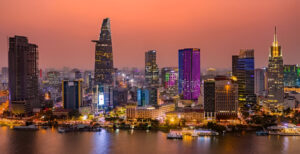 রাতের সায়গন শহরের মোহময়ী রূপ।
রাতের সায়গন শহরের মোহময়ী রূপ।
*******
অচেনা ভিয়েতনাম দ্বিতীয় পর্ব
War Remnants Museum
দ্বিতীয় পর্বের এই ভ্রমণকাহিনীটি একটি ডকুমেন্টের মতন করে এটি লেখা। ভ্রমণকাহিনী নয়, ইতিহাসের মতন করে এটিকে পড়তে হবে। সায়গন War Remnants Museum দেখার পর ভিয়েতনাম যুদ্ধে মার্কিনী বর্বরতার চেহারা আমি এখানে যথাসাধ্য বর্ননা দেবার চেষ্টা করেছি। লিখে সবকিছু বোঝানো সম্ভব নয়, তাই অনেকগুলো ফটো দিতে হয়েছে। সেই কারণেই এই War Remnants Museum নিয়ে আমার লেখা কম, ফটো অনেক।
War Remnants Museum, নানান কারণে বিদেশীদের কাছেও এর আকর্ষণ সর্বাধিক। বিগত শতকে ভিয়েতনাম বাদ দিলে পৃথিবীর আর ক’টা দেশ দু’দুবার স্বাধীনতা যুদ্ধ করেছে জানা নেই। প্রথম ইন্দোচীন যুদ্ধ (ফ্রান্স, ১৯৪৬), তারপর ভিয়েতনাম যুদ্ধের (মার্কিন যুক্তরাষ্ট্র, ১৯৭৫) স্মারক নিয়েই ভিয়েতনাম সরকার এই যাদুঘর তৈরি করেছে যেখানে বছরে প্রায় পাঁচ লাখ ট্যুরিষ্ট আসেন। একসময় এর নাম ছিলো Exhibition House for US and Puppet Crimes (Nhà trưng bày tội ác Mỹ-ngụy). উল্লেখযোগ্য যে, স্বাধীনতা যুদ্ধের সময় এইখানেই ছিলো United States Information Agency, সেপ্টেম্বর ১৯৭৫ সালে আমেরিকানরা ভিয়েতনাম ছেড়ে সদলবলে পলায়ন করলে (সহজ কথায় বিতারিত) আমেরিকানদেরই বিশেষ গুরুত্বপূর্ণ এই সরকারি ঘাঁটিতেই এই যাদুঘরটি প্রতিষ্ঠিত হয়। এবং এখন এইখানেই আমেরিকান বর্বরতার নিদর্শন বিশেষ যত্ন সহকারে প্রদর্শিত হয়। তাঁদের ভাষায় a tradition of exposing war crimes, first those of the French and then those of the Americans.
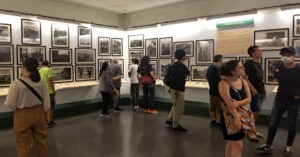
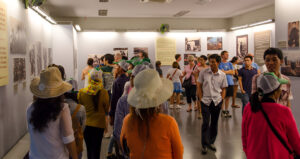
প্রথমে এই জগতখ্যাত যাদুঘরের নাম ছিলো Museum of Chinese and American War Crimes, ১৯৯০ সালে নামের পরিবর্তন হয় Exhibition House for Crimes of War and Aggression (Nhà trưng bày tội ác chiến tranh xâm lược), আর ১৯৯৫ সালে ক্লিন্টন সাহেবের দৌলতে আমেরিকার সাথে কূটনৈতিক সম্পর্কের খানিকটা উন্নতি হওয়ায় পর War and Aggression কথাগুলো বাদ দিয়ে নতুন নাম রাখা হয় War Remnants Museum.
দ্বিতীয় বিশ্বযুদ্ধ পর্যন্ত ইউরোপ, আমেরিকা, এবং এশিয়ার জাপান ও চীন ধারাবাহিকভাবে অন্যদেশে নিজেদের আধিপত্য দেখিয়েছে। divide & rule, সে ভারত-পাকিস্তান হোক, কোরিয়া হোক, এমনকি NATO আর Warshaw Pact এর দুইদলে মিলে পরম শক্তিধর জার্মানীকেও দুই’ভাগ করে দিলো। পাকিস্তান আবার দু’ভাগ, পূর্ব আর পশ্চিম। বিশ্বযুদ্ধের পর শক্তিধর দেশগুলির লক্ষ্য ছোট ছোট দেশ, যারা শিক্ষায় অনুন্নত, দুর্বল প্রতিরক্ষা, বিজ্ঞান ও প্রযুক্তির অভাব, কৃষিকাজ ছাড়া ব্যাবসা বানিজ্য বিশেষ কিছুই নেই, এইরকম দেশগুলি। সুতরাং দূরবীনে ভিয়েতনাম একটি ভালো টার্গেট। সহজ কথায়, দুর্বল দেশগুলি চুপচাপ ভালো ছেলে হয়ে থাকো, আমরাই তোমাদের দেখাশোনা করবো। তোমারই দেশের একজন ভালো লোককে আমরাই খুঁজে নেবো যে তোমাদের দেশ শাসন করবে। সেই লোকটিকে আমরা পিছনে থেকে মদত দেবো। তোমরা শান্তিতে থাকো।
১৯৫৪ সালে ফ্রান্স ভিয়েতনাম থেকে বিদায় নেওয়ার পরেও সেখানে আবার নিজের আধিপত্য বিস্তারের চেষ্টা করে। তখন ময়দানে নামে আমেরিকা, সোভিয়েত ইউনিয়ন, আর চীন। এবার ভিয়েতনাম, যে আন্তর্জাতিক জটিল রাজনীতির কিছুই বোঝে না সেই দেশটা দুইভাগে ভাগ হয়ে নিজেদের মধ্যে গৃহযুদ্ধ শুরু করে দিলো। দক্ষিণের শাসনব্যাবস্থা বকলমে আমেরিকার দখলে, আর উত্তরে হো চি মিনের নেতৃত্বে কমিউনিস্টরা। মার্কিন প্রেসিডেন্ট Dwight D Eisenhower বলেন, fall of French Indochina to communists could create a “domino” effect in Southeast Asia. সুতরাং domino theory র বাহানায় আমেরিকা সরকার Ngo Dinh Diem নামের নিজেদের পছন্দের ভিয়েতনামী লোকটিকে দক্ষিণ ভিয়েতনামের গদিতে বসিয়ে দিলো। আবার কিছুদিন বাদেই এই লোকটিকে সরিয়ে অন্য একজন নিরীহ ভালো লোককে খুঁজে এনে গদিতে বসালো।

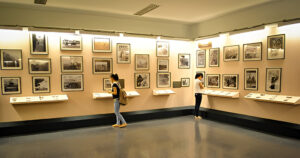
War Museum এর আলোচনায় ফিরে আসি।
সকাল্ দশটায় পৌঁছে, এই যাদুঘরের বিল্ডিং এর ঠিক বাইরেই দেখি পুরনো কিছু ফাইটার প্লেন, আর যুদ্ধের ট্যঙ্ক। এগুলি আমেরিকা ব্যাবহার করেছিলো। লোকজন ফটো তুলছে, আমরাও তুললাম। টিকিটের দাম বেশি নয়, মাত্র চল্লিশ হাজার VND ($1.75), মানে আমাদের ভারতীয় মুদ্রায় মাত্র ১৪০ টাকা। এত সস্তা, মূলত কূটনৌতিক আর রাজনৈতিক কারণে। অনুমান করা কঠিন নয় যে ভিয়েনামের সরকার চায় আমদুনিয়ার লোক এখানে একটিবার যেন পদধূলি দেয়। তবে এতকিছু করেও কোন সরকারি গাইড নেই, আছে শুধু হেডফোন গাইড। কানে লাগিয়ে দিলে অন্যপ্রান্তের টেপ রেকর্ডার নির্দেশ দেয় আমি ডাইনে যাবো, না কি সামনে না কি বাঁয়ে? আর ছবি দেখিয়ে ঘটনাবলীর বর্ননা দেয়। তুমি কিছু না বুঝলেও যন্ত্রটির কোন মাথব্যাথা নেই। মাঝপথে প্রশ্ন করাও বেকার, অর্থহীন। এই টেপ রেকর্ডার শুধু নিজেই কথা বলে, অন্যের কথা শোনে না।
গাইড বা হেডফোন ছাড়াই ভেতরে ঢুকে গেলাম। তিনতলা মিউজিয়ামের বিভিন্ন ঘরে বিভিন্ন থীমের স্মারক রাখা। বাইরে রাখা আছে যুদ্ধে ব্যাবহৃত হেলিকপ্টার, ফাইটার প্লেন, ট্যাঙ্ক। ভেতরে আছে Daisy Cutter বোমা, Skyraider attack বোমা, Dragonfly attack বোমা ও আরও নানান ধরণের বোমা। আপাতত সেগুলি নিস্ক্রিয়। আরও আছে বিভিন্ন মারনাস্ত্র, সামরিক ভাষায় defoliant sprays, napalm আর phosphorus বোমা। এইসব বোমা বা অস্ত্রের নাম শুনে আমার মতন সাধারণ লোক কিছুই বুঝবে না, কিন্তু বর্বরতার আন্দাজ পাবে।


যে সময়ের ছবিগুলি এখানে দেখানো হয়, তখন ভিয়েতনাম খুবই অনুন্নত দেশ। তখন এখানে কোন সোস্যাল মিডিয়া ছিলো না, খুবই সীমিত সংবাদপত্র। টিভি নেই, রেডিও যৎসামান্য। তথ্য সরবরাহ মানে শুধুই বিদেশী সংবাদের কোম্পানিগুলি, যেগুলি ছিলো আমেরিকান সেনার চক্ষুশূল। বহু বিদেশী সাংবাদিক ভিয়েতনামে এসে আমেরিকান সেনাদের দয়ায় নিখোঁজ হয়ে যায়। বিভিন্ন সোর্স থেকে সেই যুদ্ধের সময়ের লুকিয়ে তোলা কিছু সাদাকালো ফটো পাওয়া যায়, আর আছে যৎসামান্য রঙিন ফটো। যা পাওয়া গেছে, সেই ফটোগুলিই এখানে সযত্নে রক্ষিত আছে।
জাদুঘরটি দেখার পর, আমার ব্যাক্তিগত মতামত এই যে যারা একসময় গলা বাজিয়েছিলেন তোমার নাম আমার নাম ভিয়েতনাম, বা বাংলা হবে ভিয়েতনাম, তাঁরা নিজেদের নোংরা সংকীর্ণ রাজনৈতিক স্বার্থে ভিয়েতনামের মুক্তিযুদ্ধকে অপমানই করেছেন। এনাদের ধারণাই নেই যে কিভাবে একটি দেশ, যাঁদের শিক্ষা নেই, বিজ্ঞান বানিজ্য নেই, তাঁদের বেঁচে থাকাটাই ছিলো যুদ্ধ। যাঁদের কৃষি আর ক্ষুদ্র কুটিরশিল্প ছাড়া আর কিছুই ছিলো না; তাঁরা বিশ্বের পরম শক্তিধর দুটি দেশের বিরুদ্ধে ৪০ টি বছর আমরণ যুদ্ধ করে গেছেন। এঁরা আমেরিকার ট্যাঙ্ক আক্রমণ করেছে, কিন্তু নিজের দেশের ট্রাম, বাস পোড়ায় নি। অন্যদিকে UNESCO, Geneva এগুলি ছিলো শুধুই খাতায় কলমে, কেউ ভিয়েতনামের হয়ে গলা বাজায় নি। চীন আর সোভিয়েত ইউনিয়ন নানানভাবে পরোক্ষ মদত দিয়ে গেছে। আমি সোনার বাংলার পতন দেখেছি, ভিয়েতনাম নিয়ে খানিক পড়াশোনাও করেছি। এখনে এসে ভিয়েতনাম যুদ্ধের অনেক কিছুই জানলাম। যারা সোনার বাংলাকে ধ্বংস করে দিলেন, শিক্ষাব্যাবস্থা কুক্ষিগত করলেন, কলকারখানা বন্ধ করে দিলেন, রাস্তায় ট্রাম বাস পোড়ালেন, সেই তাঁদের মুখে ভিয়েতনাম, ভিয়েতনাম গলাবাজি আর শোভা পায় না।
আবার War Remnants Museum প্রসঙ্গে ফিরে আসি।
আমরা প্রায় তিনঘন্টা ছিলাম, এবং মনোযোগ সহকারেই সবকিছু বোঝার চেষ্টা করেছি, ঘটনাগুলি কল্পনা করার চেষ্টা করেছি। অত্যাচারের নিদর্শনগুলি সাজিয়ে রাখা আছে। আর আছে প্রচুর সাদাকালো এমন সব ফটো, যেগুলির সামনে দাঁড়িয়ে থাকা যায় না। ভিয়েতনাম যুদ্ধের ফিল্ম বা ভিডিও সাধারণত দেখা যায় না। আমেরিকা এদেশের লোকেদের উপর কি অমানবিক অত্যাচার করেছে, এই ফটোগুলি দেখলে ধারনা করা যায়। শুধু বিপ্লবী মুক্তিযোদ্ধা নয়, নিরীহ গ্রাম্য লোকজন, মহিলা, শিশু কেউ বাদ যায় নি। ১৯৭৫ সালে যে দেশের জনসংখ্যা ছিলো সাড়ে চার কোটি, সেই দেশের বিশ লাখ লোককে নির্বিচারে হত্যা করা হয়। পাঁচ লাখ লোক বোমায়, বিষাক্ত গ্যাসে চিরকালের জন্য বিকলাঙ্গ হয়ে যায়। ভবিষ্যতের কয়েকটি তরুণ প্রজন্ম বিলীন হয়ে যায়।

“Tiger Cages” নামের একটি খাঁচায় কিছু রাজনৈতিক বন্দীদের রাখা হতো। এই টাইগার কেজের ছাদ নেই, চারদিকে কাঁটাতারে ঘেরা। সেখানে গরম বালুর উপর বন্দীদের শুয়ে থাকা ছাড়া সোজা উঠে বসারও উপায় নেই। তৃষ্ণার জলও দেওয়া হতো না। গরমে গায়ে ঘা হয়ে, বা প্রচন্ড গরমের তাপে হাজার হাজার লোক এমনিতেই মারা গেছে। ছিল লোহার কাঁটার বাক্সের কফিন। এ ছাড়াও গরম লোহার কড়াইয়ের উপর হাতপা বেঁধে যুদ্ধবন্দীদের ছেড়ে দেওয়া হতো। আর ১৯৬০ সাল পর্যন্ত ফ্রেঞ্চ আর আমেরিকার সরকার যে গিলোটিন ব্যাবহার করেছিলো, সেটিও এখানে আছে।
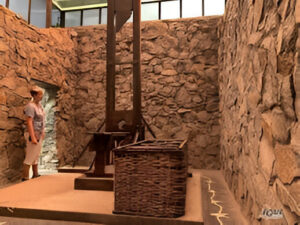

******
 Battle of Saigon, the First Offensive, on February 10, 1968.
Battle of Saigon, the First Offensive, on February 10, 1968.
Photo: Eddie Adams/AP
******
Phu Quoc Prison (Vietnamese: Nhà tù Phú Quốc)
১৯৪৯ সালে ফরাসীরা, প্রধানত Viet Cong রাজনৈতিক বন্দীদের জন্য Phu Quoc অঞ্চলে ৪০,০০০ স্কোয়ার মিটার জায়গা জুড়ে একটি বন্দীশালা তৈরি করে Phu Quoc Prison (Vietnamese: Nhà tù Phú Quốc)। ক্রমে এটি ত্রাসের বন্দীশালা নামে কুখ্যাত হয়। আন্তর্জাতিক অনুরোধে ১৯৬৯ আর ১৯৭২ সালে ইন্টারন্যাশনাল রেড ক্রস থেকে প্রতিনিধিরা এটির পরিদর্শনে আসেন, এবং অপ্রতুল খাদ্য, চিকিৎসা ও অমানুষিক অত্যাচারের বিস্তারিত রিপোর্ট পেশ করেন। ১৯৭৫ সালের এপ্রিলে যুদ্ধজয়ের পর (Fall of Saigon) এটি বন্ধ করে দেওয়া হয়, এবং বর্তমানে এটি একটি মিউজিয়াম।
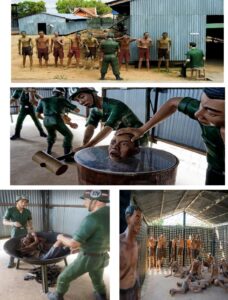
******
Agent Orange
এজেন্ট অরেঞ্জ, কেমিস্ট্রির ভাষায় a chemical herbicide and defoliant used by the U.S. military during the Vietnam War (1961-71). It is a mixture of two herbicides. In addition to its damaging environmental effects, have caused major health problems for many individuals who were exposed, and their offspring. এই এজেন্ট অরেঞ্জ স্প্রে হওয়ার ফলে হাজার হাজার লোক চিরকালের জন্য বিকলাঙ্গ হয়ে যায়।
 War Remnants Museum কিছু জারে Human Fetuses (বাংলায় কি বলবো? ভ্রূণ?) রাখা আছে যেগুলি নষ্ট হয়েছে exposure due to dioxins and dioxin-like compounds, contained in the defoliant Agent Orange.
War Remnants Museum কিছু জারে Human Fetuses (বাংলায় কি বলবো? ভ্রূণ?) রাখা আছে যেগুলি নষ্ট হয়েছে exposure due to dioxins and dioxin-like compounds, contained in the defoliant Agent Orange.

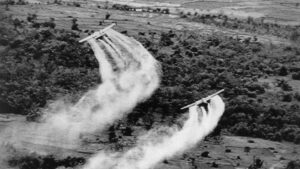

It is estimated that 4.8 million Vietnamese have been exposed to dioxin, including about 3 million Agent Orange victims (many of them are children). Tens of thousands of people have died in a painful death and resentment due to incurable diseases. Many female victims have experienced reproductive problems. Many of them have been deprived of being a mother. The most disastrous is that their offsprings, those who did not take part in the war also become Agent Orange victims with born malformations.

Agent Orange was usually sprayed from helicopters or from low-flying C-123 Provider aircraft, fitted with sprayers and “MC-1 Hourglass” pump systems and 1,000 U.S. gal (3,800 L; 830 imp gal) chemical tanks. Spray runs were also conducted from trucks, boats, and backpack sprayers. Altogether, over 80,000,000 L (21,000,000 US gal) of Agent Orange were applied.
U.S. Air Force records at least 6,542 spraying missions took place over the course of Operation Ranch Hand. By 1971, 12 percent of the total area of South Vietnam had been sprayed with defoliating chemicals, at an average concentration of 13 times the recommended by the Department of Agriculture. In South Vietnam, an estimated 100,000 km2 of agricultural land was ultimately destroyed. The campaign destroyed 20,000 km2 (7,700 sq. mi) of upland and mangrove forests and thousands of square kilometers of crops.
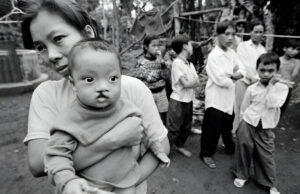



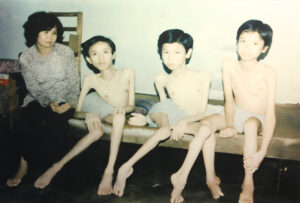
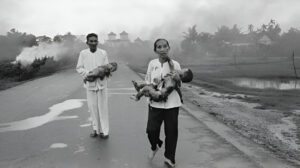
A legal precedent has paved the way for Vietnam to demand Monsanto pay compensation to the many victims of Agent Orange, during the Vietnam War. The company, now part of Bayer AG after an acquisition went through, was ordered to pay $289 million in restitution to Johnson, a former pest control manager for a California country school system, after a jury at San Francisco’s Superior Court in California ruled that.
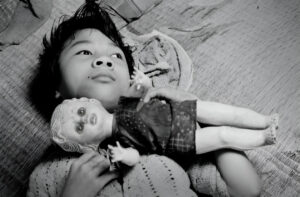
*******
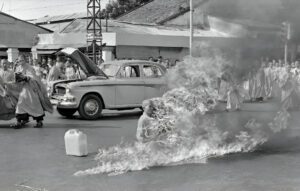
১১ই জুন, ১৯৬৩
বৌদ্ধ সন্ন্যাসীদের উপর দক্ষিণ ভিয়েতনাম সরকারের অকথ্য অত্যাচারের প্রতিবাদে সন্ন্যাসী Thich Quảng Đức প্রকাশ্য রাজপথে নিজের গায়ে আগুন দিয়ে আত্মাহুতি করেন।
Photo: Journalist Malcolm Browne. এটি The 1963 World Press Photo of the Year বিচারে সেরা ফটোর স্বীকৃতি পায়।
The photograph aroused worldwide outrage and hastened the end of the Ngo Dinh Diem government. With the photograph on his Oval Office desk, President Kennedy remarked to his ambassador: “We’re going to have to do something about that regime.”
Before closing my eyes to Buddha, I respectfully plead to President Ngo Dinh Diem, asking him to be kind and tolerant toward his people and to enforce a policy of religious equality.
– The last written words of Thich Quang Duc, a Buddhist monk who burned himself to death to protest the regime in South Vietnam, 1963
I was too shocked to cry, too confused to take notes or ask questions, too bewildered to even think.
– New York Times correspondent David Halberstam, a witness to the self-immolation of a Buddhist monk in Saigon, June 1963
No news picture in history has generated so much emotion around the world as that one.
– US President John F. Kennedy
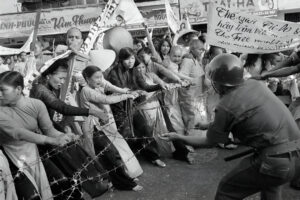 ১৭ জুলাই ১৯৬৩, ফটো সৌজন্যে: চিত্রসাংবাদিক Horst Faas (AP)
১৭ জুলাই ১৯৬৩, ফটো সৌজন্যে: চিত্রসাংবাদিক Horst Faas (AP)
সায়গন শহরে Giac Minh Pagoda র বাইরে পুলিশ ব্যারিকেড করে নিরীহ বৌদ্ধ মন্দির ও সন্ন্যাসীদের উপর আক্রমণ চালায়। পরের মাসেই পুলিশ ও মিলিটারি (Diem regime) দেশজুড়ে ধর্মীয় স্থানগুলিতে তল্লাশি চালায়।
*******

Young guerrilla girls and boys with bombs tightened with their belts
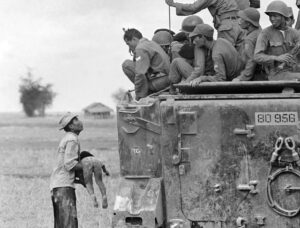 ১৯ মার্চ, ১৯৬৪
১৯ মার্চ, ১৯৬৪
ভিয়েতনামী গেরিলাদের সন্ধানে এসে সেনারা বিনা কারণে একটি নিরীহ শিশুকে হত্যা করে শিশুটির মৃতদেহ পরিবারের হাতে তুলে দিয়ে চলে যায়।
ফটো সৌজন্যে: চিত্রসাংবাদিক Horst Faas (AP)
(1965 Pulitzer prize for photography)
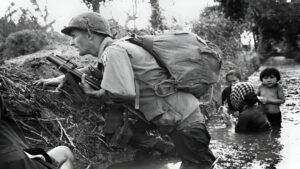
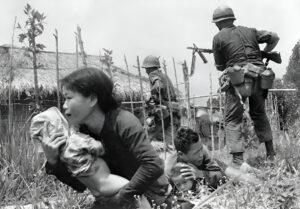 ২৫ এপ্রিল, ১৯৬৫
২৫ এপ্রিল, ১৯৬৫
Under Operation Sniper Fire, a Vietnamese woman carries a child to safety as US marines storm the village named My Son, near Da Nang, searching for Vietcong insurgents, As was typical in such situations, the men of the village had mostly disappeared, and the remaining villagers revealed little when questioned.
ফটো সৌজন্যে: চিত্র সাংবাদিক Eddie Adams (AP)
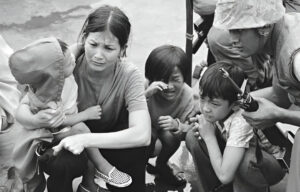 April 29, 1975:
April 29, 1975:
A South Vietnamese mother and her three children are shown on the deck of an amphibious command ship being plucked out of Saigon by US Marine helicopters
Credit: AP
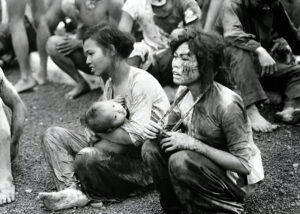
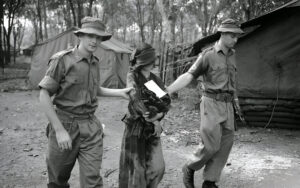 October 29, 1966. (AP)
October 29, 1966. (AP)
A Vietnamese girl, 23 years old, was captured by an Australian patrol 30 feet below ground at the end of a maze of tunnels some 10 miles west of the headquarters of the Australian task force (40 miles southeast of Saigon). The woman was crouched over a World War II radio set. About seven male Viet Cong took off when the Australians appeared—but the woman remained and appeared to be trying to conceal the radio set. She was taken back to the Australian headquarters where she told under sharp interrogation (which included a “waterprobe”; see her wet clothes after the interrogation) that she worked as a Viet Cong nurse in the village of Hoa Long and had been in the tunnel for 10 days. The Australians did not believe her because she seemed to lack any medical knowledge. They thought that she may have possibly been the leader of the political cell in Long Hoa. She was being led away after interrogation, clothes soaked from the “waterprobe”.
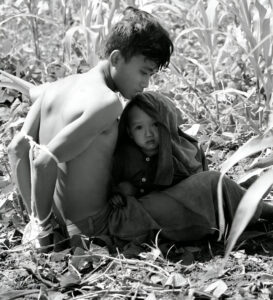 February 17, 1966.
February 17, 1966.
A Vietnamese child clings to his bound father who was rounded up as a suspected Viet Cong guerrilla during “Operation Eagle Claw” in the Bong Son area, 280 miles northeast of Saigon. The father was taken to an interrogation camp with other suspects rounded up by the U.S. 1st air cavalry division.
(Richard Merron, Henri Huet/AP)
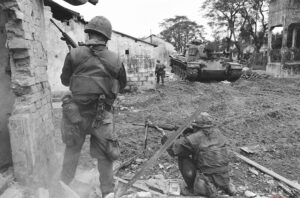
January 31, 1968.
A soldier, upper left, climbs from balcony to balcony while another, helmeted in center foreground, fires into a room during an effort to flush out Viet Cong fighters in a still-under construction hotel in Saigon, near the South Vietnamese presidential palace. South Vietnamese and U.S. forces combined to halt an attack on the capital by the Cong guerrilla forces.
AP Photo.
Command spokesman said 4,959 enemy were killed in action from 6 p.m. Monday to midnight Wednesday. Another 1,862 persons were seized as Viet Cong suspects. U.S. casualties for the period were listed as 232 killed and 929 wounded. South Vietnamese government casualties were 300 killed and 747 wounded, a spokesman said. Other allied casualties were put at three killed and 22 wounded.
South Vietnamese authorities said 660 Viet Cong were killed in Saigon alone in less than two days of fighting. There was no immediate word on the number of civilian casualties in the capital or elsewhere across the nation, but they were believed to have been heavy.
******
Operation Rolling Thunder
বোমাবর্ষণের কিছু উল্লেখ করি।
১৯৬৫-১৯৭৫, এই ১০ দশ বছর সময়ে ভিয়েতনাম, লাওস ও কম্বোডিয়ায় ৭৫লাখ টন বোমাবর্ষণ হয়, যা দ্বিতীয় বিশ্বযুদ্ধে ইউরোপ ও এশিয়ায় সম্মিলিত বোমাবর্ষণের দ্বিগুণ। শুধু অপারেশন রোলিং থান্ডারের নামেই ৮৬৪,০০০ টন বোমাবর্ষণ হয় (ক্রিসমাস বম্ব)। মানব ইতিহাসে এটি সবথেকে বড় aerial bombardment.
 জুন, ১৯৬৫ “Déjà Vu”
জুন, ১৯৬৫ “Déjà Vu”
ফটো সৌজন্যে: চিত্র সাংবাদিক Horst Faas (AP)

১৯৬৫
আমেরিকান বায়ুসেনা এসে নির্দেশ দেয় যে সেই মূহুর্তেই গ্রাম (Qui Nhon গ্রাম) খালি করে দিতে হবে। নিরুপায় গ্রামবাসীরা যে যেভাবে পারে পালিয়ে যায়।
ফটো সৌজন্যে: Kyoichi Sawada, United Associated Press.
(1966 Pulitzer Prize)
অপারেশন রোলিং থান্ডার পৃথিবীর ইতিহাসের একটি চরম বর্বরতার উদাহরণ। মার্চ ১৯৬৫ থেকে শুরু করে নভেম্বর ১৯৬৮ পর্যন্ত এই সাড়ে তিন বছর আমেরিকান বিমান বাহিনী (2nd Air Division, পরে 7th Air Force), নৌবাহিনী আর ভিয়েতনাম এয়ার ফোর্স (Republic of Vietnam Air Force, RVNAF) একসাথে ভিয়েতনামের উপর লাগাতার আক্রমন চালায়। তুলনা করলে পুরো কোরিয়ান যুদ্ধে বোমাবর্ষন হয় ৬৫৩,০০০ টন, দ্বিতীয় বিশ্বযুদ্ধে প্যাসিফিক থিয়েটারে হয় ৫০৩,০০০ টন। আর এই অপারেশন রোলিং থান্ডারেই বোমাবর্ষন হয়েছিলো ৮৬৪,০০০ টন। আমেরিকার বিমান আক্রমণ করেছিলো ১৫৩,৭৮৪ বার, নৌবাহিনী করেছিল ১৫২,৩৯৯ বার।
একটা কথা বুঝতে হবে, ভাবতে হবে। বিশ্বযুদ্ধ হয়েছিল কয়েকটি দেশের মধ্যে, যেখানে প্রতিপক্ষ উভয় দেশগুলিই ছিল শক্তিশালী। কিন্তু ভিয়েতনামের ক্ষেত্রে বিশ্বের একটি পরম শক্তিধর দেশ অন্য একটি দুর্বল দেশের ভুখন্ড অন্যায়ভাবে দখল করার জন্য নিরীহ লোকেদের উপর বিশ্বযুদ্ধের থেকেও অধিক আক্রমণ চালিয়েছে। বিশ্বযুদ্ধে জার্মানির উপর আমেরিকা যে বোমাবর্ষন করেছে, ভিয়েতনামের তুলনায় সে ছিলো অতি নগন্য।
১৯৬৪ সালের মার্চ মাসে অপারেশন রোলিং থান্ডার আক্রমণের পরিকল্পনা করেছিলেন আমেরিকার Commander in Chief, Pacific (CINCPAC)। (CINCPAC OPLAN 37–64), ৯৪ টি টার্গেট স্থির হয়, ব্রিজ, নৌবন্দর, রেলপথ, ব্যারাক আর খাদ্য ও পণ্য সরবারাহ সিস্টেমের উপর। ভিয়েতনাম গেরিলা নেতারা অপারেশন রোলিং স্টোনের কিছু আগেই এর আন্দাজ পেয়ে যান, এবং ১৯৬৫ ফেব্রুয়ারি মাসেই গেরিলাবাহিনীকে সতর্ক করে দেন। “… complete destruction of the entire country, including Hanoi and Haiphong. The communist leadership declared “a people’s war against the air war of destruction…each citizen is a soldier, each village, street, and plant a fortress on the anti-American battlefront.” All except those deemed “truly indispensable to the life of the capital” were evacuated to the countryside. By 1967, Hanoi’s population had been reduced by half.”
যদিও সোভিয়েত ইউনিয়ন আর চীন যুদ্ধাস্ত্র দিয়ে সাহায্য করেছিলো, কিন্তু সরাসরি যুদ্ধে নামেনি, কারণ তাহলে আরও একটি বিশ্বযুদ্ধের আশংকা ছিল, এবং আমেরিকা কূটনৈতিকভাবে সেই সুযোগটি নিয়েছে। অন্যদিকে বিদেশী যুদ্ধাস্ত্র পেলেও সামান্য কিছুমাত্র গেরিলা সেগুলির ব্যাবহারের উপযুক্ত ট্রেনিং পেয়েছিল, অন্যেরা ধীরে ধীরে নিজেরাই সেগুলির ব্যাবহার শিখে নেয়।
অপারেশন রোলিং থান্ডারের শুরুতে গেরিলাদের দখলে ছিল ১,৫০০টি লাইট ৩৭ আর ৫৭ এমএম এন্টি এয়ারক্রাফট মেশিন। সোভিয়েত আর চীনের সাহায্যে এক বছরে সেই সংখ্যা হয়ে যায় ৫ হাজার এবং সাথে ৮৫ আর ১০০ এমএম রাডার ডাইরেক্টেড যুদ্ধাস্ত্র। ১৯৬৭ সালে সংখ্যা বেড়ে দাঁড়ায় ৭ হাজার। আমেরিকা ধারণাই করতে পারেনি যে গেরিলারা এত যুদ্ধাস্ত্র সংগ্রহ করতে পারে, যার ফলে ভিয়েতনামের গেরিলারা ৮০ শতাংশ আমেরিকান বিমান ধ্বংস করতে পেরেছিলো।
১৯ মে, ১৯৬৭ সালে রবার্ট ম্যাকনামারা আমেরিকার প্রেসিডেন্টকে মেমো লেখেন, “… There may be a limit beyond which many Americans and much of the world will not permit the United States to go. The picture of the world’s greatest superpower killing or seriously injuring 1,000 non-combatants a week, while trying to pound a tiny, backward nation into submission on an issue whose merits are hotly disputed, is not a pretty one.”
উপরে যথাসম্ভব সংক্ষেপে অপারেশন থান্ডার লিখলাম। একদিকে আমেরিকার আগ্রাসী সাম্রাজ্যবাদী বর্বরতা, লোভ ও যুদ্ধাস্ত্রের প্রয়োগ, অন্যদিকে ম্যাকনামারার ভাষায় tiny, backward nation ভিয়েতনামের গেরিলাদের গৌরবজনক প্রতিরক্ষার ইতিহাস।
******
 ২৫ শে আগস্ট, ১৯৬৫
২৫ শে আগস্ট, ১৯৬৫
ফটো সৌজন্যে: Associated Press.
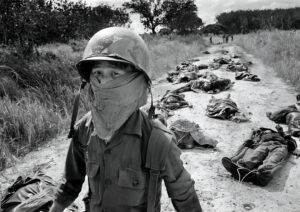 ২৭ নভেম্বর, ১৯৬৫,
২৭ নভেম্বর, ১৯৬৫,
The South Vietnamese stretcher-bearer wears a face mask to protect himself from the smell as he passes the bodies of US and South Vietnamese soldiers killed fighting the Vietcong in the Michelin rubber plantation.
ফটো সৌজন্যে: চিত্র সাংবাদিক Horst Faas (AP)
Michelin rubber plantation এর জমিতে (সায়গনের ৭২ কিলোমিটার উত্তর পশ্চিমে, সায়গন ও কম্বোডিয়ার মাঝে) Viet Cong (VC) 271st and 273rd Regiments সাথে গেরিলা যুদ্ধে আনুমানিক ৫০০ আমেরিকান সেনা আর পাঁচজন US Adviser নিহত হয়। অন্যদিকে এই যুদ্ধে নিহত হয় প্রায় ১০০ ভিয়েতনামী সেনা (7th Regiment, 5th Division). এরপর আমেরিকা Operation Bloodhound (১-৬ ডিসেম্বর, ১৯৬৫, পরে নামকরন হয় Operation Bushmaster II) এ আমেরিকান সেনা পাঠানো হয়। তার সাথে চলে বিমান হানা।

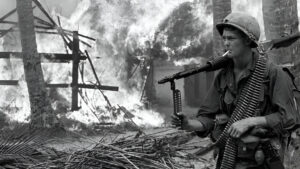
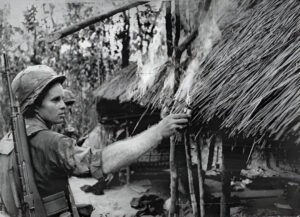 November 15, 1965:
November 15, 1965:
A US Army officer sets fire to a hut in a Viet Cong training camp captured by the First Infantry Division during an attack on a stronghold 50 miles north west of Saigon
Credit: AP

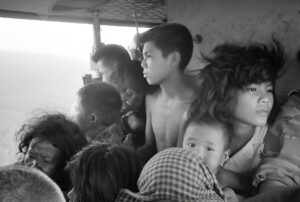 May 5, 1970.
May 5, 1970.
Vietnamese and Cambodian refugees crowd a U.S. helicopter which evacuated them from immediate combat zone of the U.S.-Vietnamese incursion into Cambodia. They were taken to a refugee reception center at the Katum Special Forces camp in South Vietnam, six miles from the Cambodian border.
Photo: Ryan/AP.
 ১ জানুয়ারি, ১৯৬৬
১ জানুয়ারি, ১৯৬৬
সেনাবাহিনীর (173rd Airborne Brigade Paratroopers) আক্রমণে ভীত গ্রামবাসীরা (Bao Trai গ্রাম, সায়গনের ২০ মাইল পশ্চিমে) ঘর ছেড়ে পালাচ্ছেন। পিছনে আমেরিকান প্যারাট্রূপার হাতে গ্রেনেড নিয়ে।
ফটো সৌজন্যে: চিত্র সাংবাদিক Horst Faas (AP)
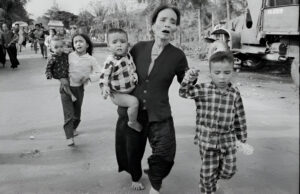
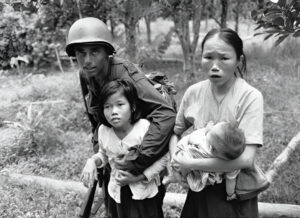
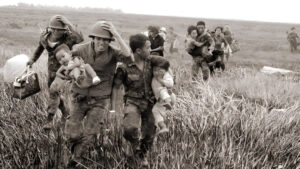

২৭ অক্টোবর, ১৯৬৭
আমেরিকান সেনারা একটি গ্রাম (Tam ky, সায়গন থেকে ৩৫০ মাইল) জ্বালিয়ে দিয়ে ঘরে মজুত সামান্য খাদ্যটিও আগুনে ছুঁড়ে ফেলে দেয়।
ফটো সৌজন্যে: চিত্রসাংবাদিক Dang Van Phuoc (AP).
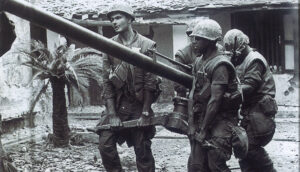
Bob Wallace (far left) helps carry a 400-pound 106mm recoilless rifle through the streets of Huê´, Vietnam, during the Tet Offensive in 1968.
Photo courtesy of Bob Wallace
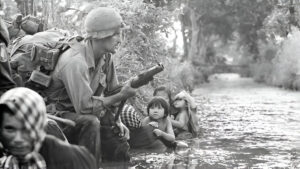
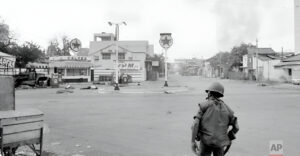 The bodies of some of the seven blindfolded people executed by the Viet Cong lie near gas pumps in the Cholon section of Saigon during the Tet Offensive on Feb. 9, 1968. The area had not yet been secured to recover the bodies. (AP Photo/Eddie Adams)
The bodies of some of the seven blindfolded people executed by the Viet Cong lie near gas pumps in the Cholon section of Saigon during the Tet Offensive on Feb. 9, 1968. The area had not yet been secured to recover the bodies. (AP Photo/Eddie Adams)
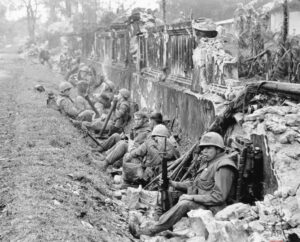
February 2, 1968
Widespread, savage fighting ranged into the fifth day in key South Vietnamese cities Saturday. The U.S. Command reported 12,704 enemy had been killed since Monday evening in allied counterattacks that were said to be crushing the biggest Communist offensive of the war.
Fresh fighting broke out in parts of Saigon, and masses of civilians were reported fleeing a battle in a northern suburb of the capital.
Photo: Edwin Q. White, Saigon, (AP)
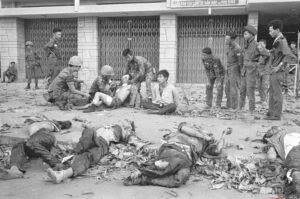
The U.S. Command said enemy fighters were killed at a rate of 124-plus per hour during the 102-hour period from 6 p.m. last Monday through Friday midnight, making the total 12,704. Allied forces also reported they detained 3,576 enemy suspects.
A total 983 allied troops were killed in the 102-hour period, including 318 Americans and 661 South Vietnamese. Allied wounded totaled 3,483, of whom 1,639 were Americans and 1,792 South Vietnamese.
While the Communists held parts of several cities and towns across the country, President Nguyen Van Thieu declared: “The back of the Viet Cong attack has been broken. We can consider they have been totally defeated.”
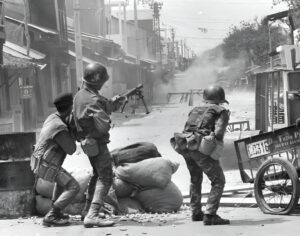
*******
Mỹ Lai Massacre.
My Lai, an infamous name of the Vietnam War. It’s a little Oradour-sur-Glane in Vietnam. My Lai, located in the province of Quang Ngai, 130 kilometers from Hoi An, is a topographic denomination of the US Army to designate two hamlets in Son My village where the massacre of My Lai happened. During the Vietnam War, on March 16, 1968, a battalion of the US Army massacred 504 civilian villagers, including women, children and old men. The American general William Westmoreland congratulated these men for “exceptional action” and for “bringing a heavy blow to the enemy”. Can we really talk about enemies when it comes to babies, old people or unarmed people?
 ১৬ই মার্চ, ১৯৬৮
১৬ই মার্চ, ১৯৬৮
The Mỹ Lai massacre, নিরস্ত্র মহিলা ও শিশুদের গুলিবিদ্ধ মৃতদেহ
ফটো সৌজন্যে: চিত্র সাংবাদিক Ronald L. Haeberle
“I was ordered to go in there and destroy the enemy. […] That was my job on that day. That was the mission I was given. I did not sit down and think in terms of men, women and children.”
– Lieutenant William Calley, testifying at Court-Martial in defense of his actions.
আমেরিকান বর্বরতার অনেক ছবি, বিশেষ করে The Mỹ Lai massacre (Thảm sát Mỹ Lai) যে কোন সুস্থ লোককেই বিচলিত করে দেয়। ১৬ই মার্চ, ১৯৬৮ সালের Mỹ Lai massacre এ আমেরিকান সেনাদের দুটি রেজিমেন্ট আনুমানিক ৫০৪ জন নিরীহ নিরস্ত্র লোককে নির্বিচারে গুলি করে হত্যা করে। এর মধ্যে ১৭৩ জন শিশু ও ১৮২ জন মহিলাও ছিলেন। অনেক মহিলা গণধর্ষণের শিকার হয়েছিলেন, এমনকি শিশুদেরও রেহাই দেওয়া হয় নি।
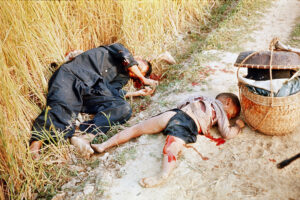
According to US military intelligence, a Viet Cong unit was operating in the area of Quang Ngai province and routed to My Lai, a hamlet in Son My village. On the morning of March 16, 1968, at approximately 7:30 am, an infantry company, under Lieutenant William Calley, was dropped off by helicopter and entered My Lai. The American soldiers completely closed the village but did not find a single fighter while the villagers, who were preparing to go to market, did not panic nor flee. The villagers were gathered while orders were given to burn houses, kill livestock, destroy foodstuffs and plug wells. Then for no reason, an incredible surge of many acts of savagery began, an inhuman rampage fell on the local population, GI’s began to attack everything that moved, humans and animals, with grenades and machine guns, assisted by combat helicopters. It was a real carnage. The soldiers shot and killed unarmed men, women, children and babies. Women were raped when some victims were mutilated with the “C Company” signature carved on their chest before being shot. “After this tragedy, we counted:
50 victims were 0 to 3 years old
69 victims were between 4 and 7 years old
91 victims were 8 to 12 years old
27 were over 70 years old.”
Seeing this massacre horrified, an American helicopter pilot, Hugh Thompson, landed his helicopter in front of soldiers who were committing abuses against the civilian population and ordered his men to point their guns at the GI’s and shot them down if they tried to violate the villagers. Then warning two other armed helicopters, together they managed to evacuate more than a dozen survivors.
Official Army photographer Ron Haeberle traveled with Charlie Company into My Lai on March 16, 1968. The Company was told that dozens of Viet Cong troops were passing through the area, retreating from battle after the Tet Offensive. Captain Ernest Medina had told his men that all Vietnamese remaining in My Lai after their arrival would be Viet Cong members or sympathizers.
Following the massacre, during which between 347 and 504 civilians were killed, the story remained largely out of the public eye until the media published Haeberle’s photographs in November 1969. These photographs would became key evidence in the Army’s five-month investigation led by General William R. Peers.
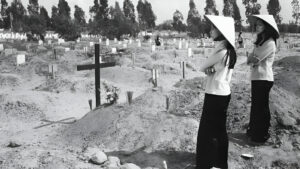
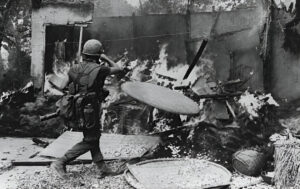
Mỹ Lai massacre ঘটনায় আন্তর্জাতিক কূটনৈতিক চাপে ২৬ জন আমেরিকান সেনার বিচার শুরু হয়, ২২ টি গ্রামের নিরীহ নিরস্ত্র লোককে নির্বিচারে হত্যার অভিযোগে। বিচারে শাস্তি হয় শুধু লেফটেন্যান্ট উইলিয়াম ল’স ক্যালির, যাবজ্জীবন কারাদন্ডের, কিন্তু প্রেসিডেন্ট রিচার্ড নিক্সনের কৃপায় তিনি মাত্র তিন বছরের গৃহবন্দীর (House Arrest, Fort Benning) শাস্তি ভোগ করেন।
******
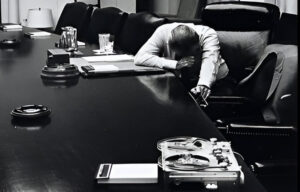 আমেরিকান রাষ্ট্রপতি লিন্ডন জনসন হোয়াইট হাউসের অফিসে নিজের জামাই ক্যাপ্টেন চার্লস রব-এর পাঠানো টেপ শুনছেন। চার্লস রব ছিলেন ভিয়েতনামে U.S. Marine Corps এর কম্যান্ডার।
আমেরিকান রাষ্ট্রপতি লিন্ডন জনসন হোয়াইট হাউসের অফিসে নিজের জামাই ক্যাপ্টেন চার্লস রব-এর পাঠানো টেপ শুনছেন। চার্লস রব ছিলেন ভিয়েতনামে U.S. Marine Corps এর কম্যান্ডার।
(ফটো সৌজন্যে: Jack Kightlinger/AP via Atlantic In Focus)
 ১৯৬৮ সাল, আমেরিকার শিকাগো শহর যখন যুদ্ধবিরোধী বিক্ষোভে উত্তাল, তখন মার্কিন প্রেসিডেন্ট জনসন ও তাঁর পরিবার টেক্সাস স্টোনওয়ালে নিজের খামারবাড়িতে শয়নকক্ষের টিভিতে বিক্ষোভ দেখছেন।
১৯৬৮ সাল, আমেরিকার শিকাগো শহর যখন যুদ্ধবিরোধী বিক্ষোভে উত্তাল, তখন মার্কিন প্রেসিডেন্ট জনসন ও তাঁর পরিবার টেক্সাস স্টোনওয়ালে নিজের খামারবাড়িতে শয়নকক্ষের টিভিতে বিক্ষোভ দেখছেন।
(সূত্র Yoichi Okamoto—LBJ Library). Pete Souza, former White House photographer for Presidents Reagan and Obama wrote: This is truly an incredibly intimate picture. The caption provides pertinent information about the circumstance: the who, what and where. But I’m fascinated by the photograph because of the man behind the camera: Yoichi Okamoto. The first civilian hired as Chief White House Photographer, Okamoto also became the first one to truly document the Presidency for history. It’s obvious looking at this photograph that he had unfettered access to LBJ and that everyone was comfortable with him being in the room — even when the room was the President’s bedroom.
*******
Tet Offensive
Tết ভিয়েতনামের একটি বড় উৎসব। প্রাচীন বিশ্বাস মতে সেইদিন বহু লোক মন্দিরের দেওয়ালে নিজেদের ইচ্ছাগুলি (wishes) লিখে দিয়ে যান।
উৎসবের দিনে চরম নিন্দাজনক ও দুঃখজনক উদাহরণ হলো আমেরিকানদের বিরুদ্ধে স্বাধীনতা যুদ্ধের সময়কালে ১৯৬৮ সালের ৩০শে জানুয়ারির The Tet Offensive, সেই আমলের একটি পরিকল্পিত বিরাট সেনা আক্রমণ (a major escalation and one of the largest military campaigns of the Vietnam War). মার্কিন সেনারা জানতো যে সেই বিশেষ দিনে সাধারণ লোকজন সকলেই উৎসবের আনন্দে থাকবে, হয়তো গেরিলারাও। তাই এক অতর্কিত ভয়াবহ আক্রমণের পরিকল্পনা করা হয়। ভিয়েতনামের ইতিহাসে মার্কিন সরকার বহু অমানবিক ঘটনার নিদর্শন রেখে গেছে। কিন্তু একটি বিশেষ উৎসবের দিনে দেশের নিরীহ সাধারণ লোকেদের উপর এইধরনের আক্রমণ পৃথিবীর ইতিহাসে বিরল।
 ফেব্রুয়ারি ১, ১৯৬৮, এই ফটোটির পরিচয় হয় “decisive moment”
ফেব্রুয়ারি ১, ১৯৬৮, এই ফটোটির পরিচয় হয় “decisive moment”
দক্ষিণ ভিয়েতনাম পুলিশের প্রধান জেনারেল General Nguyen Ngoc Loan সায়গন শহরে প্রকাশ্য দিবালোকে সন্দেহবশত (Tet Offensive) ভিয়েতকং নেতা Nguyen Van Lem কে পিস্তল দিয়ে (small Smith & Weston detective pistol) মাথায় গুলি মারেন। পুরো ঘটনাটি ঘটে AP চিত্রসাংবাদিক Eddie Adams, ও NBC এবং ABC ক্যামেরাদলের সামনে। Eddie Adams এর ভাষ্য অনুযায়ী General Nguyen Ngoc Loan এসে বলেন “They killed many of my people, and yours too,”
এরপর আমেরিকান টিভি এই ফটো সারা দেশে প্রদর্শিত করে।
Photograph: Eddie Adams/AP
(1969 Pulitzer prize for spot news photography)
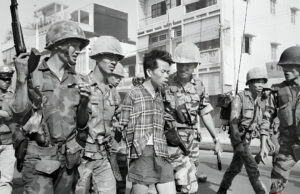
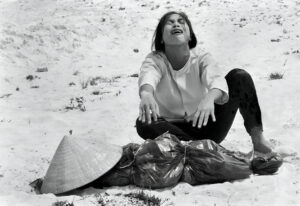 ১১ এপ্রিল ১৯৬৯
১১ এপ্রিল ১৯৬৯
Hue অঞ্চলে ৪৭টি মৃতদেহ খুঁজে পাওয়া যায়, অনুমান আমেরিকান Tet offensive
A woman mourns over the body of her husband after identifying him by his teeth and covering his head with her conical hat.
Photograph: Horst Faas/AP
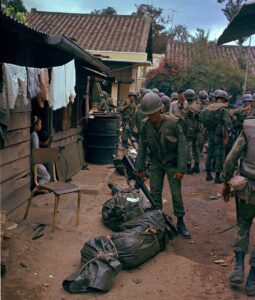
February 1, 1968, (AP Photo).
The bodies of civilians and Viet Cong litter the street after bitter fighting in the early days of the Tet Offensive, in the northern section in Saigon, South Vietnam,
In the Chinese Cholon section of the capital, fighting broke out in front of a children’s hospital. Cholon was hit by six Viet Cong mortar shells during the night. At Hue, a main gate of the citadel was reported wrested from Communist control. The U.S. Command said the enemy withdrew into the northern part of the old walled areas under repeated strafing and rocket raids by allied fighter-bombers. A report from President Johnson on the toll of aircraft at American fields said that 16 planes and 23 helicopters were destroyed and about 100 other planes so severely damaged that they would have to be replaced. The average cost of American warplanes is estimated at $2 million.

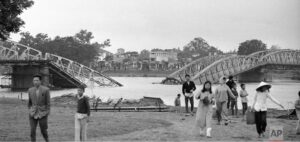
February. 6, 1968.
The main bridge across the Perfume River, connecting two parts of Hue, was blown up by Viet Cong. The ancient Vietnamese imperial city is 50 miles south of he demilitarized zone in South Vietnam.
(AP Photo/Rick Merron).
Particularly intense fighting took place in the city of Hue, located on the Perfume River some 50 miles south of the border between North and South Vietnam. The toughest fighting in Hue occurred at the ancient citadel, which the North Vietnamese struggled fiercely to hold against superior U.S. firepower. In scenes of carnage recorded on film by numerous television crews on the scene, nearly 150 U.S. Marines were killed in the Battle of Hue, along with some 400 South Vietnamese troops. On the North Vietnamese side, an estimated 5,000 soldiers were killed, most of them hit by American air and artillery strikes. “What I saw was probably the most intense ground fighting on a sustained basis over several days of any other period during the war,” Howard Prince, a U.S. Army captain, later told NPR.
“We didn’t know where the enemy was, in which direction even,” Mike Downs, a Marine captain, told NPR.
Despite its heavy casualty toll, and its failure to inspire widespread rebellion among the South Vietnamese, the Tet Offensive proved to be a strategic success for the North Vietnamese.
আজকাল উগ্র চরমপন্থী আতঙ্কবাদীরা ধর্মীয় দিনে নিরীহ মানুষের উপর আক্রমণ চালায়। কিন্তু একটি দেশের সরকার যে এরকম করতে পারে, আমেরিকাই তার একমাত্র উদাহরণ।


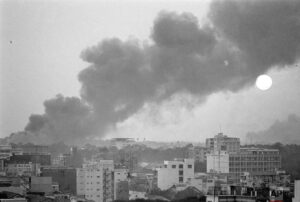
February 8, 1968.
Smoke rises over battle-scarred Saigon during the Tet Offensive as the sun sets over the South Vietnamese capital. Savage fighting was continuing there for the ninth consecutive day with Viet Cong guerrillas pitted against combined South Vietnamese and U.S. forces.
(AP Photo/Eddie Adams)
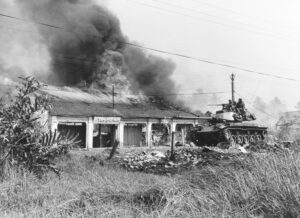
February 19, 1968.
A South Vietnamese soldier fires a machine gun into burning buildings in northeastern Saigon, Vietnam, where Viet Cong forces occupied several city blocks during the Tet Offensive. Early on the morning of Jan. 31, 1968, as Vietnamese celebrated the Lunar New Year, or Tet as it is known locally, Communist forces launched a wave of coordinated surprise attacks across South Vietnam. The campaign, one of the largest of the Vietnam War, led to intense fighting and heavy casualties in cities and towns across the South. (AP Photo/Dang Van Phuoc)

February 8, 1968.
US soldiers rest on top of a tank at the Phu Tho racetrack in western Saigon. US and South Vietnamese troops set up a fire support base at the track to support troops engaged in mop-up operations throughout the city during the Tet Offensive.
(AP Photo/Eddie Adams)
While battles raged for more than a month in some places like the city of Hue, the Tet Offensive was from a strictly military standpoint a defeat for the North Vietnamese and Viet Cong forces. Yet the campaign had a profound impact on the U.S. war effort, stunning leaders in Washington and leaving the American public questioning their country’s involvement in the overseas campaign.
******
 ৩০ শে জুলাই, ১৯৬৯
৩০ শে জুলাই, ১৯৬৯
প্রেসিডেন্ট নিক্সন সায়গন শহরে আমেরিকান সৈন্যদের সাথে (First Division at Di An)। প্রেসিডেন্ট থাকাকালীন এটি নিক্সনের first as president and অষ্টমবারের জন্য ভিয়েতনামের সরকারি সফর।
(Photo: Bob Daugherty/AP)
 ২০শে এপ্রিল, ১৯৭০
২০শে এপ্রিল, ১৯৭০
মার্কিন হামলায় আহত মহিলা Vo Thi Phuong হাসপাতালে, পাশেই অসহায় শিশুপুত্র।
ফটো সৌজন্যে: Don Hirst/Overseas Weekly Collection/Hoover Institution Library and Archives
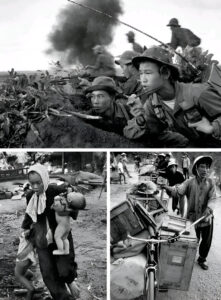
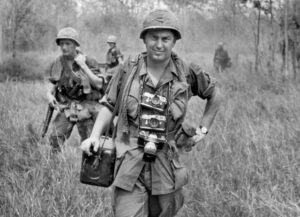 AP photographer Horst Faas, with his cameras around his neck, accompanies US troops in war zone C
AP photographer Horst Faas, with his cameras around his neck, accompanies US troops in war zone C
Photograph: AP
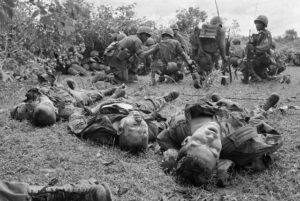 18 September 1965.
18 September 1965.
Bodies of US paratroopers lie near a command post during the battle of An Ninh. The paratroopers, of the 1st Brigade, 101st Airborne Division, were hit by heavy fire from guerrillas that began as soon as the first elements of the unit landed. The dead and wounded were later evacuated to An Khe, where the 101st was based. The battle was one of the first of the war between major units of US forces and the Vietcong
Photograph: Henri Huet/AP
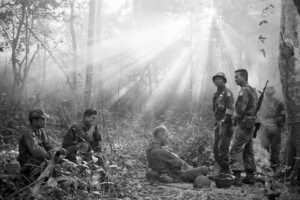 January 1965.
January 1965.
Sunlight breaks through dense foliage around the town of Binh Gia as South Vietnamese troops, joined by US advisers, rest after a tense night of waiting in an ambush position for a Vietcong attack that did not come.
Photograph: Horst Faas/AP
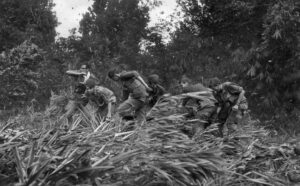 4 May 1970.
4 May 1970.
Life magazine photographer Larry Burrows (far left) struggles through elephant grass and the rotor wash of an American evacuation helicopter as he helps GIs carry a wounded soldier on a stretcher from the jungle to the chopper in Mimot, Cambodia. The evacuation came during the US incursion into Cambodia. Burrows was killed on 10 February 1971, along with the photographer who took this picture, Henri Huet, and two other photojournalists – Kent Potter of UPI and Keisaburo Shimamoto of Newsweek – when their helicopter was shot down over Laos
Photograph: Henri Huet/AP
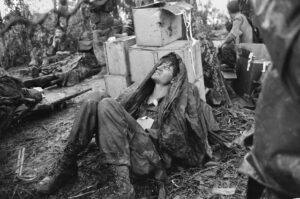 19 May 1969.
19 May 1969.
A US paratrooper, wounded in the battle for Hamburger Hill, grimaces in pain as he awaits medical evacuation at base camp near the Laotian border.
Photograph: Hugh Van Es/AP
 10 January 1966.
10 January 1966.
Caught in a sudden monsoon rain, part of a company of about 130 South Vietnamese soldiers moves downriver in sampans during a dawn attack on a Vietcong camp. Several guerrillas were reported killed or wounded in the action 13 miles northeast of Can Tho, in the flooded Mekong Delta
Photograph: Henri Huet/AP
 25 September 1965.
25 September 1965.
US paratroopers of the 2nd Battalion, 173rd Airborne Brigade, hold their automatic weapons above water as they cross a river in the rain during a search for Vietcong positions in the jungle area of Ben Cat. The paratroopers had been combing the area for 12 days with no enemy contact
Photograph: Henri Huet/AP
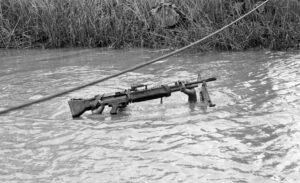 10 September 1968.
10 September 1968.
A 6ft 5in machine gunner with the US 9th Infantry Division is submerged except for his rifle as he crosses a muddy stream in the Mekong delta south of Saigon.
Photograph: Henri Huet/AP
 17 February 1968.
17 February 1968.
Marines transport their seriously wounded atop a US army tank through the streets of Hue toward a helicopter evacuation point. Tanks were the only vehicles able to travel the streets because of rubble from buildings destroyed during the still-ongoing Tet offensive. The marines came under sniper fire several times on the journey
Photograph: AP Archive
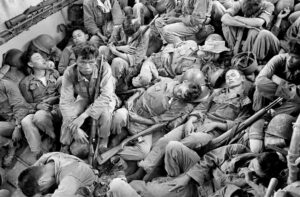 Exhausted South Vietnamese soldiers sleep on a US Navy troop carrier taking them back to the provincial capital of Ca Mau in August 1962. The infantry unit had been on a four-day operation against the Vietcong in swamplands at the southern tip of the country
Exhausted South Vietnamese soldiers sleep on a US Navy troop carrier taking them back to the provincial capital of Ca Mau in August 1962. The infantry unit had been on a four-day operation against the Vietcong in swamplands at the southern tip of the country
Photograph: Horst Faas/AP
 Marines emerge from their foxholes south of the DMZ after a third night of fighting against North Vietnamese troops in September 1966. The helicopter on the left was shot down when it came in to resupply the unit
Marines emerge from their foxholes south of the DMZ after a third night of fighting against North Vietnamese troops in September 1966. The helicopter on the left was shot down when it came in to resupply the unit
Photograph: Henri Huet/AP
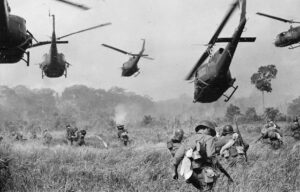 Hovering US Army helicopters pour machine-gun fire into the tree line to cover the advance of South Vietnamese ground troops as they attack a Vietcong camp 18 miles north of Tay Ninh, near the Cambodian border, in March 1965
Hovering US Army helicopters pour machine-gun fire into the tree line to cover the advance of South Vietnamese ground troops as they attack a Vietcong camp 18 miles north of Tay Ninh, near the Cambodian border, in March 1965
Photograph: Horst Faas/AP
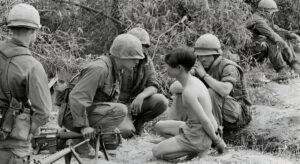 US Marines interrogate a prisoner during a search and destroy mission in January 1968
US Marines interrogate a prisoner during a search and destroy mission in January 1968
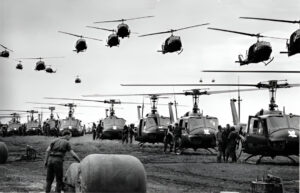 1966: US Army helicopters providing support for ground troops fly into a staging area 50 miles northeast of Saigon
1966: US Army helicopters providing support for ground troops fly into a staging area 50 miles northeast of Saigon
Credit: AP Photo: Henri Huet
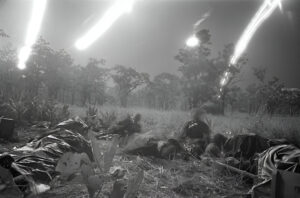 Flares from planes light a field covered with the dead and wounded of the ambushed battalion of the U.S. 1st Cavalry Division in the Ia Drang Valley, Vietnam, on November 18, 1965, during a fierce battle that had been raging for days. Units of the division were battling to hold their lines against what was estimated to be a regiment of North Vietnamese soldiers. Bodies of the slain soldiers were carried to this clearing with their gear to await evacuation by helicopter.
Flares from planes light a field covered with the dead and wounded of the ambushed battalion of the U.S. 1st Cavalry Division in the Ia Drang Valley, Vietnam, on November 18, 1965, during a fierce battle that had been raging for days. Units of the division were battling to hold their lines against what was estimated to be a regiment of North Vietnamese soldiers. Bodies of the slain soldiers were carried to this clearing with their gear to await evacuation by helicopter.
Photo: Rick Merron/AP
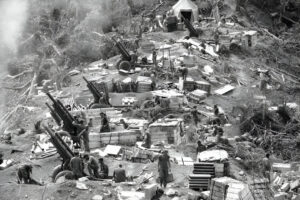 Marines prepare their 105-mm Howitzers for action at the end of a day in which this dense jungle area west of Hue was chopped down and molded into a fire-support base for a sweep of the area on February 18, 1969. (Dang Van Phuoc/AP)
Marines prepare their 105-mm Howitzers for action at the end of a day in which this dense jungle area west of Hue was chopped down and molded into a fire-support base for a sweep of the area on February 18, 1969. (Dang Van Phuoc/AP)
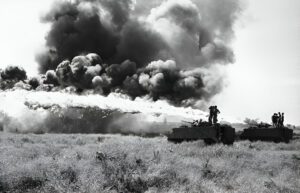 South Vietnamese troopers test fire flame throwers mounted atop APCs prior to moving out on operation west of Krek, Cambodia, on November 28, 1971.
South Vietnamese troopers test fire flame throwers mounted atop APCs prior to moving out on operation west of Krek, Cambodia, on November 28, 1971.
Photo: Jacques Tonnaire/AP

Photographer Huynh Thanh My, pinned down with a Vietnamese battalion in a Mekong Delta rice paddy on 13 October 1965, about a month before he was killed while covering combat. His younger brother, Nick Ut, later came to work for the AP as a photographer
Photograph: AP
******
The Kent State Massacre
১৯৬৮ সালে প্রেসিডেন্ট পদের রিপাবলিকান প্রার্থী রিচার্ড নিক্সন ভিয়েতনাম যুদ্ধের মীমাংসার প্রতিশ্রুতি দিয়েছিলেন। ২০শে এপ্রিল, ১৯৭০ সালে তিনি ঘোষনা করেন ১,১৫,০০০ সৈন্য ইতিমধ্যেই ফিরে এসেছে (withdrawn) এবং ১৯৭১ সালের মধ্যে আরও ১,৫০,০০০ সৈন্য ফিরে আসবে। কিন্তু এরপর ৩০শে এপ্রিল রিচার্ড নিক্সন টিভিতে বলেন, U.S. and South Vietnamese troops were mounting a major invasion of Cambodia which had provided a haven for the VietCong and North Vietnamese troops. জানা যায় যে এই ঘোষনার আগেই বোমাবর্ষণ শুরু হয়ে গিয়েছে। the “Cambodian Incursion” had been launched by United States combat forces.
পরদিন ১লা মে ১৯৭০ কেন্ট স্টেট ইউনিভার্সিটির ছাত্ররা জমায়েত হয়ে ৪থা মে প্রতিবাদ দিবস পালনের সিদ্ধান্ত নেয়। তাঁদের ভাষায় এই সিদ্ধান্ত “bring the war home.” Black United Students (BUS) এর ছাত্ররাও সেই সিদ্ধান্তে সায় দেয়। দিনের শেষে নিক্সন পেন্টাগনে এলে একজন মহিলা বলেন, “I loved your speech. It made me proud to be an American” এবং জবাবে নিক্সন বলেন, “Listen, the boys that are on the college campuses today are the luckiest people in the world, going to the greatest universities, and here they are burning up the books, storming around this issue. You name it. Get rid of the war there will be another one.”
গভর্নর রোডস বলেন, “… they make definite plans of burning, destroying, and throwing rocks at police and at the National Guard and the Highway Patrol. … They’re worse than the brown shirts and the communist element…. well-trained, militant, revolutionary group that has ever assembled in America.”
ইউনিভার্সিটি কর্তৃপক্ষ ৪ তারিখের জমায়েত অবৈধ ঘোষনা করে, কিন্তু ২০০০ নিরস্ত্র ছাত্র ইউনিভার্সিটি জমায়েত হয়। …… protest began with the ringing of the campus’s iron Victory Bell (which had historically been used to signal victories in football games). আমেরিকান ন্যাশনাল গার্ড নিজেদের প্রস্তুতি নেয় (weapons “locked and loaded” and affixed with bayonets). নির্দেশ ছিল যে শুধুমাত্র Company C র তরফে একজন প্রথমে শুন্যে গুলি চালাবে। ন্যাশনাল গার্ড এগিয়ে যায়, দুপুর ১২:২৪ মিনিটে সার্জন্ট Myron Pryor প্রথম গুলি চালায়, এবং এরপর ন্যাশনাল গার্ডের অনেকেই গুলি চালাতে শুরু করে। নিউইয়র্ক টাইমস John Kifner পত্রিকার লেখেন, “…… it appeared to go on, as a solid volley, for perhaps a full minute or a little longer.”
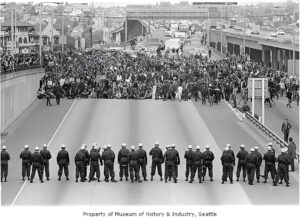
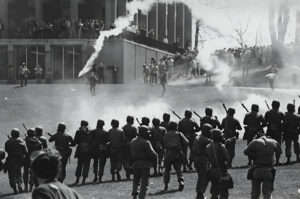
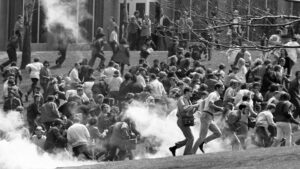

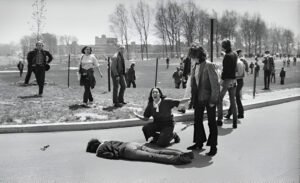 ৪ মে, ১৯৭০.
৪ মে, ১৯৭০.
১৪ বছর বয়সের Mary Ann Vecchio গুলিবিদ্ধ ও নিহত Kent State ছাত্র Jeffrey Miller এর নিথর দেহের সামনে। Ohio National Guard ভিয়েতনাম যুদ্ধবিরোধী নিরস্ত্র ছাত্রদের উপর গুলি চালায় (The Kent State Massacre, protest against the U.S. invasion of Cambodia) গুলিতে ৪ জন মারা যায়, ১৩ জন ছাত্র আহত হয়। একজন ছাত্র John Filo (Library of Congress) এই ফটোটি তুলে রাখেন। দিনের শেষে AP টিভিতে এই ফটোটি দেখানো হয়।
ফটো: (John Paul Filo).
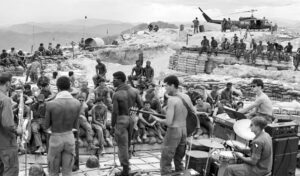 জুলাই ১৯৭০
জুলাই ১৯৭০
আমেরিকান সৈন্যদের জন্য বিনোদন (rock session) GIs of the 3rd Brigade, 101st Airborne Division,
চারিদিকে wooden bunkers, helicopter, sandbags.
ফটো সৌজন্যে: চিত্র সাংবাদিক Giancarlo Meyer/AP
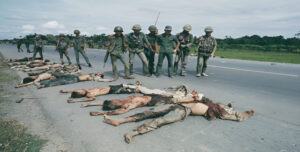 ১৯ আগস্ট, ১৯৭২
১৯ আগস্ট, ১৯৭২
খোলা রাস্তায় (Cai Be district) মার্কিন সেনার গুলিতে নিহত সাধারণ লোকজন।
ফটো সৌজন্যে: Rolls Press (Getty Images)
*******
Flaming Child from Naplam Bombing

৮ জুন ১৯৭২
প্রবল বোমাবর্ষনে ভীত সন্ত্রস্ত শিশুরা, সায়গনের ৩০ মাইল উত্তর-পশ্চিমে (আমেরিকান বিবৃতি accidentally dropped its flaming napalm on civilians, outside the village of Trang Bang)। বোমার বিস্ফোরণে ৯ বছরের Phan Thi Kim Phuc নিজের শরীরের জলন্ত কাপড় খুলে প্রাণভয়ে পালাচ্ছে। পিছনেই সেনাবাহিনী, South Vietnamese army’s 25th Division
ফটো সৌজন্যে: চিত্রসাংবাদিক Nick Ut (Associated Press) (1973 Pulitzer prize for spot news photography). এই ফটোটির পরিচয় “Napalm Girl”.
সেইদিন বায়ুসেনাদের Skyraider প্লেন যে napalm বোমাটির বর্ষণ করে, সেটি মানুষের শরীর জ্বালিয়ে দেয়। আমেরিকার বিবৃতি অনুযায়ী, Tragically, the group was mistaken for the enemy, seeking Vietcong hiding places accidentally dropped its flaming napalm on civilians and government troops instead.
Phan Thi Kim Phuc বলেন “I turned my head and saw the airplanes, and I saw four bombs landing down. Then, suddenly, there was fire everywhere, and my clothes were burned up by the fire. At that moment I didn’t see anybody around me, just fire. I will never forget that moment, I still remember what I thought: Oh my goodness, I got burned, I will be ugly, and people will see me different way. But I was so terrified.”
তরুণ ভিয়েতনামী ফটোগ্রাফার Nick Ut (তখন ২১ বছর বয়স) পরে লস এঞ্জেলেস ভিডিওতে বলেন, “I saw Kim running and she screamed in Vietnamese ‘Too hot! Too hot!’” “I saw that her body was burned so badly, and I wanted to help her right away. I put all my camera gear down on the highway and put water on her body.” Nick Ut তখনই Phuc কে নিজের অফিসের গাড়িতে নিয়ে হাসপাতালে যায়, কিন্তু সেখানে গিয়ে জানতে পারে কোন জায়গা নেই। তাঁকে সায়গন শহরে যেতে হবে। “I said, ‘If she goes one more hour (without treatment), she will die,” তাঁর ধারণা ছিলো Phuc ইতিমধ্যে গাড়িতেই মারা গেছে। Nick Ut শেষ পর্যন্ত নিজের প্রেস কার্ড দেখিয়ে ডাক্তারদের বোঝায়, আর তখন ডাক্তাররা চিকিৎসা করতে রাজি হয়। (he recalled his exact words to the hospital as: “If one of them dies you’ll be in trouble.”)
সেই হাসপাতাল থেকেই Nick Ut সায়গনে Associated Press অফিসে গিয়ে ফটোগুলো জমা দেয় আর সেগুলি তৎক্ষণাৎ সারা দুনিয়ায় ছড়িয়ে যায়। “the skin of her back and arms scorched by the flammable jelly that made napalm such a controversial weapon.” “When I went back to my office, the (dark room technician) and everyone who saw the picture told me right away it was very powerful, and that the photo would win a Pulitzer.” এবং সত্যি এই ফটোটি ১৯৭৩ সালে Pulitzer Prize for spot news photography পুরস্কার পায়।
১৯৯২ সালে Kim Phuc রাজনৈতিক পুনর্বাসন নিয়ে কানাডায় চলে যান। এখানে এসে she felt inspired to use her personal tragedy for wider good. তিনি Kim Foundation International গঠন করেন, উদ্দেশ্য যুদ্ধে ক্ষতিগ্রস্ত শিশুদের সাহায্য করা। ১৯৯৭ সালে তিনি United Nations Goodwill Ambassador নিযুক্ত হন এবং পৃথিবীর বিভিন্ন দেশে গিয়ে নিজের অভিজ্ঞতা বর্ননা করেন। তারপর তিনি (যাকে তিনি বলে “uncle” সম্বোধন করেন), St Peter’s Square এ Pope Francis কে সেই বিশেষ স্মারক ফটোটি উপহার দেন।
“Now I can look back and embrace it… I’m so thankful that (Ut) could record that moment of history and record the horror of war, which can change the whole world. And that moment changed my attitude and my belief that I can keep my dream alive to help others.”
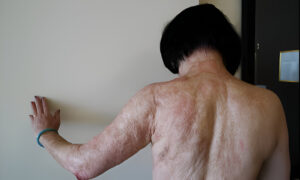
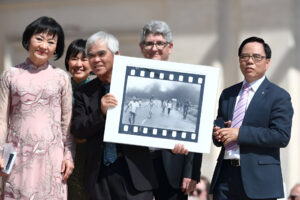
*******


November 15, 1969
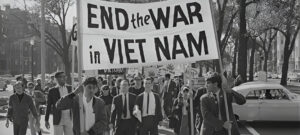 October 16, 1965.
October 16, 1965.
বোস্টন শহরের ছাত্রদের মিছিল
Courtesy of AP Photo/Frank C. Curtin.
*****
Why should they ask me to put on a uniform and go 10,000 miles from home and drop bombs and bullets on Brown people in Vietnam while so-called Negro people in Louisville are treated like dogs and denied simple human rights? No, I’m not going 10,000 miles from home to help murder and burn another poor nation simply to continue the domination of white slave masters of the darker people the world over. This is the day when such evils must come to an end. I have been warned that to take such a stand would cost me millions of dollars. But I have said it once and I will say it again. The real enemy of my people is here. I will not disgrace my religion, my people or myself by becoming a tool to enslave those who are fighting for their own justice, freedom and equality. If I thought the war was going to bring freedom and equality to 22 million of my people they wouldn’t have to draft me, I’d join tomorrow. I have nothing to lose by standing up for my beliefs. So I’ll go to jail, so what? We’ve been in jail for 400 years.
Muhammad Ali
Redemption Song: Muhammad Ali and the Spirit of the Sixties
There is at the outset a very obvious and almost facile connection between the war in Vietnam and the struggle I, and others, have been waging in America. A few years ago there was a shining moment in that struggle. It seemed as if there was a real promise of hope for the poor — both black and white — through the poverty program. There were experiments, hopes, new beginnings. Then came the buildup in Vietnam, and I watched this program broken and eviscerated, as if it were some idle political plaything of a society gone mad on war, and I knew that America would never invest the necessary funds or energies in rehabilitation of its poor so long as adventures like Vietnam continued to draw men and skills and money like some demonic destructive suction tube.
Martin Luther King, Jr.
at Riverside Church, New York City,
“A Time to Break Silence”, April 4, 1967
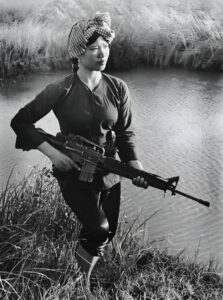
১৯৭২ সাল, Soc Trang Province
মুক্তিযোদ্ধা Lam Thi Dep (ভিয়েতনামে Dep শব্দের অর্থ সুন্দরী)
ফটো সৌজন্যে: ভিয়েতনামী সাংবাদিক Minh Truong. “You could find women like her almost everywhere during the war”, Minh Truong বলেন. “She was only 24…”
“She had tried to live an honest life, but the war had given her no choice. It had forced her to make up a version of herself which was acceptable to others. In a way, making up stories had been the basis of her survival and her success.”
― Nguyễn Phan Quế Mai, the author of Dust Child
“The Vietnam War remains, then, studying the war is an intellectual undertaking and a valuable exercise in civic responsibility. According to estimate, more than 30,000 books have been published about the war, a number will no doubt grow to even more staggering heights as authors gain access to new sources, especially from repositories outside the United States, and open new lines of inquiry.”
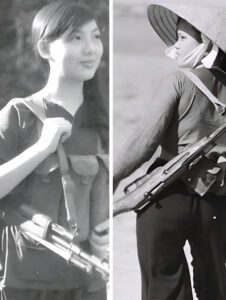
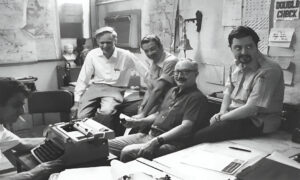
২৮ এপ্রিল ১৯৭২, সায়গন AP office
সেই সময়ের পাঁচজন প্রাক্তন, বর্তমান ও ভবিষ্যতের Bureau Chiefs.
বাঁদিক থেকে: টাইপরাইটার মেশিনে George Esper, Malcolm Browne, George McArthur, Edwin Q White and Richard Pyle
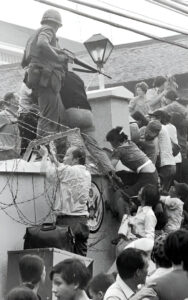
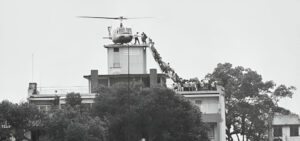 ২৯ এপ্রিল, ১৯৭৫
২৯ এপ্রিল, ১৯৭৫
আমেরিকার আত্মসমর্পণের আগে CIA র Air America হেলিকপ্টার, সায়গন প্রেসিডেন্ট প্যালেসের ছাদে, আমেরিকানদের উদ্ধারকার্য্যে।
Credit: AP Photo/Neal Ulevich
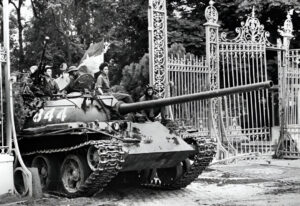
৩০ এপ্রিল, ১৯৭৫
এর আগের দিন, ২৯শে এপ্রিল, মুক্তিযোদ্ধা কমান্ডার General Văn Tiến Dũng তাঁর বাহিনী নিয়ে আমেরিকার মদতপুষ্ট আর্মি অফ রিপাবলিক অফ ভিয়েতনাম (ARVN) কমান্ডার General Nguyễn Văn Toàn কে আক্রমণ করেন। আর ৩০ এপ্রিল, ১৯৭৫ এইদিনে সকাল ১০-৪৫ মিনিটা উত্তর ভিয়েতনামী মুক্তিযোদ্ধার একটি ট্যাঙ্ক প্রেসিডেন্ট প্যালেসের গেট ভেঙে ঢুকে পড়ে (bulldozed through the main gate), এবং এখানেই ভিয়েতনাম যুদ্ধের সমাপ্তি ও বিজয়।
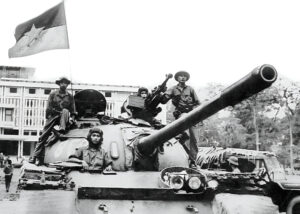
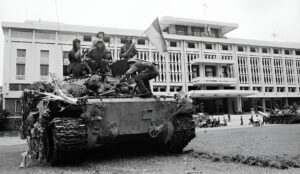 April 30, 1975:
April 30, 1975:
North Vietnamese tanks roll across the Presidential Palace grounds of the then South Vietnam in Saigon. At 11:30 a.m. local time the Vietcong flag was raised above it, signaling the end of the war. Nearly one-and-a-half million people had been killed, and a further three million wounded.
Credit: AP
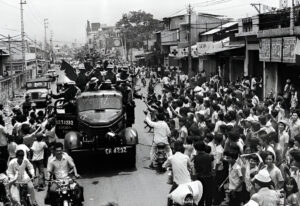
April 30, 1975: Saigon residents take to the street to welcome the arrival of communist troops on trucks after the fall of Saigon which marked the end of the Vietnam War
Credit: AFP
*******
Reunification Day (Vietnamese: Ngày Thống nhất)
ভিয়েতনামীরা নানানভাবে এই দিনটিকে পালন করেন। অনেকে বলেন বিজয়দিবস Victory Day (Ngày Chiến thắng), কেউ বলেন মুক্তিদিবস Liberation Day (Ngày Giải phóng or Ngày Giải phóng miền Nam), অথবা সরকারিভাবে Day of the Liberation of the South and National Reunification (Ngày Giải phóng miền Nam, thống nhất đất nước)।
বিদেশে রাজনৈতিকভাবে আশ্রিত কমিউনিস্ট বিরোধী ভিয়েতনামীরা এই দিনটিকে আখ্যা দিয়েছেন Black April (Tháng tư den), National Day of Shame (Ngày quốc nhục), National Day of Hate (Ngày quốc hận).

On 27th January 1973, the United States, South Vietnam, Viet Cong and North Vietnam formally signed the Paris Peace Accords, “An Agreement Ending the War and Restoring Peace in Vietnam”.
During the day on Monday, Washington time, the airport at Saigon came under persistent rocket as well as artillery fire and was effectively closed. The military situation in the area deteriorated rapidly. I therefore ordered the evacuation of all American personnel remaining in South Vietnam.
– April 29, 1975. US President Gerald Ford announcing the evacuation of all US personnel at Vietnam.
Today, America can regain the sense of pride that existed before Vietnam. But it cannot be achieved by refighting a war that is finished as far as America is concerned. As I see it, the time has come to look forward to an agenda for the future, to unify, to bind up the Nation’s wounds, and to restore its health and its optimistic self-confidence…. We, of course, are saddened indeed by the events in Indochina. But these events, tragic as they are, portend neither the end of the world nor of America’s leadership in the world.
– April 23, 1975. President Gerald R. Ford in a speech at Tulane University.
পরিশেষে, আমেরিকান কূটনীতি বড়ই জটিল। ২০১৪-২০১৫ সালে এই War Remnants Museum যাদুঘরে Agent Orange: Messages from the Heart নাম দিয়ে কিছু ফটো প্রদর্শিত হয়, যেখানে দেখানো হয় thriving survivors of war, যার কূটনৈতিক অর্থ signaling a departure from the museum’s abrasive tone towards a reconciliatory one
আমরা War Remnants Museum এ আসি সকাল দশটায়, ভালো করে পুরোটা দেখতে সময় লাগলো প্রায় তিন ঘন্টা। এবং এটি এমনই এক জায়গা, যা না দেখলে ভিয়েতনামে আমেরিকানদের অমানবিক অমানুষিক অত্যাচারের মাত্রা বোঝাই যায় না।
ভিয়েতনাম নিয়ে খুব ছোট করে বলতে হলে-
১৮৮৩ সালে ফরাসীরা এখানে উপনিবেশ স্থাপন করে। ১৯৪৫ সালে হো চি মিনের নেতৃত্বে ন্যাশনালিস্ট কোয়ালিশন ভিয়েতমিন স্বাধীনতা অর্জন করে। দ্বিতীয় বিশ্বযুদ্ধের পরে প্রথম ইন্দোচীন যুদ্ধের সময় ফ্রান্স আবার এখানে নিজেদের উপনিবেশ স্থাপনের চেষ্টা করে, কিন্তু ১৯৫৪ সালে ভিয়েতনাম আবার নিজেদের স্বাধীনতা ছিনিয়ে নেয়। ভিয়েতমিন ও ফ্রান্সের দ্বিপাক্ষিক চুক্তি অনুযায়ী দেশটি দুই ভাগে বিভক্ত হয়। এরপরেই গৃহযুদ্ধ শুরু হলে সোভিয়েত ইউনিয়ন ও চীন উত্তর ভিয়েতনামকে রাজিনৈতিক ও সামরিক সাহায্য দেয়, আর অকমিউনিস্ট দক্ষিণ ভিয়েতনামের সাহায্যে এগিয়ে আসে মার্কিন যুক্তরাষ্ট্র। ১৯৭৫ সালে আমেরিকার বিরুদ্ধে উত্তর ভিয়েতনামের বিজয় ঘোষনার ঠিক পরেই ১৯৭৬ সালে দুই ভিয়েতনাম আবার সংযুক্ত হয়।
******
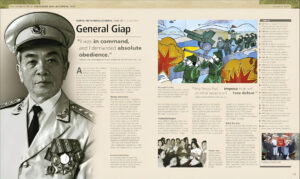
Quotes:
I covered the Vietnam War. I remember the lies that were told, the lives that were lost – and the shock when, twenty years after the war ended, former Defense Secretary Robert S. McNamara admitted he knew it was a mistake all along.
– Walter Leland Cronkite Jr., American broadcast journalist & Anchorman for the CBS Evening News for 19 years, from 1962 to 1981.
Our resistance will be long and painful, but whatever the sacrifices, however long the struggle, we shall fight to the end, until Vietnam is fully independent and reunified.
– Ho Chi Minh (December 19, 1946)
You can kill ten of my men for everyone I kill of yours. But even at those odds, you will lose, and I will win.
– Ho Chi Minh, to the French in 1946
Our long-term objectives are… to see installed a self-governing nationalist state which will be friendly to the US… We have an immediate interest in maintaining in power a friendly French Government, to assist in the furtherance of our aims in Europe. This immediate and vital interest has in consequence taken precedence over-active steps looking toward the realization of our objectives in Indochina.
– Department of State, explaining why the US supported French policy in Vietnam even though US believed it ran counter to their long-term objectives for the region. (September 27, 1948).
Now we have a problem in trying to make our power credible, and Vietnam looks like the place.
– President John F. Kennedy’s interview with the New York Times reporter James Reston. (June 1961).
I don’t think that unless a greater effort is made by the government to win popular support that the war can be won out there. In the final analysis, it is their war. They are the ones who have to win it or lose it. We can help them, we can give them equipment, we can send our men out there as advisors, but they have to win it, the people of Vietnam, against the communists.
– President Kennedy in a televised interview with Walter Cronkite. (September 2, 1963).
I am not going to lose Vietnam. I am not going to be the president who saw Southeast Asia go the way China went.
– Newly elected US President Lyndon Johnson. (November 24, 1963)
We do this [escalating U.S. military involvement in Vietnam] in order to slow down aggression. We do this to increase the confidence of the brave people of South Vietnam who have bravely born this brutal battle for so many years with so many casualties. And we do this to convince the leaders of North Vietnam—and all who seek to share their conquest—of a simple fact: We will not be defeated. We will not grow tired. We will not withdraw either openly or under the cloak of a meaningless agreement.
– President Lyndon Johnson, (April 7, 1965)
My solution to the problem would be to tell them frankly that they’ve got to draw in their horns and stop their aggression or we’re going to bomb them back into the Stone Ages.
– General Curtis E. LeMay, in his book Mission With LeMay, 1965.
It’s silly talking about how many years we will have to spend in the jungles of Vietnam when we could pave the whole country and put parking stripes on it and still be home for Christmas.
– Ronald Reagan, interview with the Fresno Bee during his California gubernatorial campaign (October 10, 1965)
Everything depends on the Americans. If they want to make war for 20 years then we shall make war for 20 years. If they want to make peace, we shall make peace and invite them to tea afterwards.
– Ho Chi Minh, December 1966
We seem bent upon saving the Vietnamese from Ho Chi Minh, even if we have to kill them and demolish their country to do it. I do not intend to remain silent in the face of what I regard as a policy of madness which, sooner or later, will envelop my son and American youth by the millions for years to come.
– Senator George McGovern, on the Senate floor (April 25, 1967).
There may be a limit beyond which many Americans and much of the world will not permit the United States to go. The picture of the world’s greatest superpower killing or seriously injuring 1,000 non-combatants a week, while trying to pound a tiny, backward nation into submission on an issue whose merits are hotly disputed, is not a pretty one.
– Robert McNamara in a memo to US President Lyndon Johnson (May 19, 1967).
It became necessary to destroy the town to save it.
– Peter Arnett, AP correspondent quoting a U.S Major on the decision to bomb and shell Ben Tre on February 7, 1968 (during the Tet Offensive) after Viet Cong forces overran the city in the Mekong Delta 45 miles south of Saigon
I refuse to believe that a little fourth-rate power like North Vietnam doesn’t have a breaking point.
– Henry Kissinger, US National Security Adviser speaking to NSC aides as he charged them with developing a punitive military strategy that would coerce North Vietnam into negotiating on American terms (July 1969).
People usually refer to the bombing of Cambodia as if it had been unprovoked, secretive U.S. action. The fact is that we were bombing North Vietnamese troops that had invaded Cambodia, [troops] that were killing many Americans from these sanctuaries, and we were doing it with the acquiescence of the Cambodian government, which never once protested against it, and which, indeed, encouraged us to do it… Why is it moral for the North Vietnamese to have 50,000 to 100,000 troops in Cambodia, why should we let them kill Americans from that territory… and why in all these conditions is there a moral issue?
– Henry Kissinger, US National Security Adviser on the bombing of Cambodia (1969)
Let us understand: North Vietnam cannot defeat or humiliate the United States. Only Americans can do that. I’m not going to be the first American president to lose a war.
– Richard M. Nixon, (November 3, 1969)
The bastards have never been bombed like they’re going to be bombed this time.
– US President Richard M. Nixon, to White House Chief of Staff H. R. Haldeman and Attorney General John Mitchell, (April 4, 1972) (deciding to launch Operation Linebacker, a massive war escalation with mining Haiphong harbour, blockading the North Vietnamese coast, and launching a massive bombing campaign against North Vietnam.)
If, when the chips are down, the world’s most powerful nation, the United States of America, acts like a pitiful, helpless giant, the forces of totalitarianism and anarchy will threaten free nations and free institutions throughout the world.
– Richard M. Nixon explaining his decision to invade Cambodia.(April 30, 1970)
No event in American history is more misunderstood than the Vietnam War. It was misreported then, and it is misremembered now.
– US President Richard M. Nixon with New York Times, (March 28, 1985)
Vietnam was a country where America was trying to make people stop being communists by dropping things on them from airplanes.
– Kurt Vonnegut, American Writer
Television brought the brutality of war into the comfort of the living room. Vietnam was lost in the living rooms of America — not on the battlefields of Vietnam.
– Marshall McLuhan, Canadian Educator, in Montreal Gazette, (May 16, 1975)
********
অচেনা ভিয়েতনাম তৃতীয় পর্ব


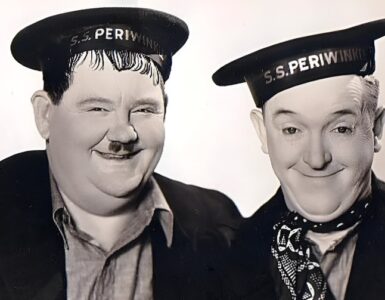
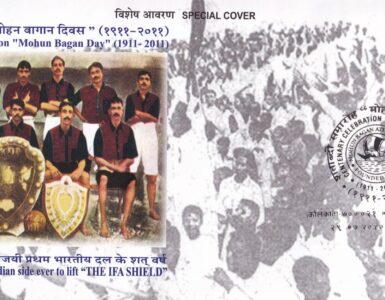
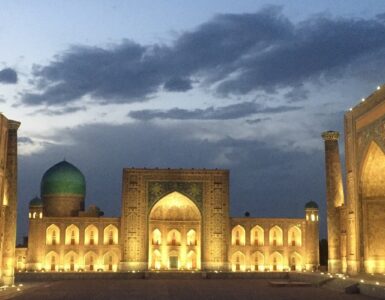










অচেনা ভিয়েতনাম পড়ে খুব ভাল লাগল।
শুরুতেই আপনি বলেছেন
The people of Germany and Japan had to rebuild their nation, as they surrendered after the shameful devastating end of the second World War in 1945. In Vietnam too, people had to rebuild their nation, though devastated but that of a glorious victory against the United States of America in 1975.
আপনি আরও বলেছেন,
much has been left unknown about the country, most remarkably about their success in establishing their identity as one of the most progressive countries of the world in the last 50 years.
আমি আপনার সাথে সম্পূর্ণ সহমত।
এবং এটাই আমার মতামত। আপনার লেখা পড়ে অনেক কিছুই জানার আছে।
শুরু থেকেই সুন্দর বাঁধুনির উপর আপনার এই লেখাটা। প্রতিটি অধ্যায় মনযোগ দিয়ে পড়তে পড়তে , সাথে ছবিগুলোর সাহায্যে চোখের সামনে যেন দেশটাকে দেখিতে পাই।
খুবই সুন্দর সাজানো লেখা।
তবে এটাকে দুই বা তিন পর্বে ভাগ করলে মনে হয় ভালো হতো।
আপনার আরও লেখা চাই, ভিয়েতনাম নিয়ে।
স্কুলে কোনোদিন ইতিহাস বা ভূগোল বইতে ভিয়েতনাম পাঠ্য বিষয় ছিল বলে মনে পড়ে না, যদিও ভিয়েতনামের যুদ্ধ ইতিহাসের পাঠ্য হওয়া উচিত বলেই মনে করি।
ভিয়েতনাম নিয়ে আমাদের মতন সাধারণ মানুষের জ্ঞান সামান্য, ভিয়েতনাম নিয়ে প্রামাণ্য বইও বাজারে কম।
লেখক অনেক পড়াশোনা করে যত্ন নিয়ে এটি লিখেছেন। ছবিগুলি থাকায় আমাদের দেশটিকে জনতে বুঝতে সুবিধে হয়েছে।
একটা ভালো সিরিজ।
সুখপাঠ্য ও অনেক কিছুই জানার আছে।
Excellent article, worth reading.
সিরিজের প্রথম পর্ব বেশ ভালো হয়েছে, আপনি বেশ নথিপত্র ঘাঁটাঘাঁটি করেছেন বুঝতে পারছি।
ভিয়েতনাম নিয়ে লেখা কিছুতেই ছোট হবে না, কোথায় দাঁড়ি টানবো? পাঠকের জন্য যেটুকু দরকার বেশ ভালো গুছিয়ে লিখেছেন।
অনেক ধন্যবাদ, ও অভিনন্দন জানাই।
War Remnants Museum আর এর সাথে মুক্তিযুদ্ধ নিয়ে লেখা অংশটুকু এক প্রামাণ্য দলিল হিসেবে পড়া যায়।
এত ছবি সংগ্রহ করতে কতটা খাটাখাটনি করতে হয়েছে আন্দাজ করতে পারি।
খুব ভালো একটা প্রবন্ধ।
অভিনন্দন।
ভিয়েতনামে মার্কিনী অমানবিক নির্যাতনের ঘটনা আমরা অনেক পরে জানতে পেরেছি। সেটাও বুড়ি ছুঁয়ে যাওয়া সংবাদের মতন।
এই লেখায় ও ছবিতে মার্কিনী অত্যাচারের কাহিনী পাতায় পাতায় ফুটে উঠেছে।
মূল্যবান লেখা, যদিও বড়ই করুণ।
মন দিয়েই পড়লাম।
শুরুতে যেমন ভালো লাগলো, War Remnants Museum পর্বে এসে অত্যাচারের বীভৎসতার বর্ণনা ও ছবি দেখে তেমনই খারাপ লাগলো। যদিও জানি সবই সত্যি, বাস্তবে এই হয়েছিল, তবু মেনে নিতে কষ্ট হয়।
লেখকের আন্তরিক প্রচেষ্টার সাধুবাদ জানাই।
প্রথম পর্ব মানে ধারাবাহিক নিশ্চয়ই হবে। ভূমিকা দিয়ে শুরু খুব ভালো হয়েছে। পুরো লেখাটাই ভ্রমণ কাহিনী আর ইতিহাস , তার সাথে ছবি, সব মিলিয়ে সুন্দর পাঠযোগ্য একটা অধ্যায়।
দ্বিতীয় ভাগে War Museum ও মুক্তিযুদ্ধ বিষয়ক অনেক কিছুই জানা ছিল না। বোঝাই যায় অনেক পরিশ্রম ও তথ্য ফটো জোগাড় করে লিখতে হয়েছে।
আগামী পর্বগুলির অপেক্ষায় থাকবো।
নমস্কার।
পর্বের দ্বিতীয় ভাগে ভিয়েতনাম যুদ্ধ নিয়ে আপনার লেখা ভালো লাগলো। প্রথমে ফ্রেঞ্চ আর পরে আরও দুই দশকের অসম যুদ্ধের সংক্ষিপ্ত ইতিহাস বেশ ভালো লিখেছেন। অনেক কিছুই জানতে পারলাম।
ধন্যবাদ
এজেন্ট অরেঞ্জ, স্নিপার ফায়ার, ফায়ার বম্ব, টাইগার কেজ, … যত রকমের সম্ভব নৃশংস অমানবিক নির্যাতনের দৃষ্টান্ত ইতিহাসের পাতায় আমেরিকা রেখে গেছে। ভিয়েতনামের যোদ্ধাদের নতমস্তকে কুর্ণিশ জানাই তাঁদের গৌরবময় বীরত্বের জন্য। ভিয়েতনামের অনমনীয় সংগ্রামের অনেক ইতিহাস লেখক ছোটর মধ্যে সুন্দর সহজ ভাষায় তুলে ধরেছেন।
বেশ ভালো লিখেছেন, প্রচুর তথ্য ও বিরল দৃশ্যর ছবিও দিয়েছেন। ভিয়েতনামের যোদ্ধাদের অসংখ্য কুর্ণিশ। আর এই অসম যুদ্ধের সংক্ষিপ্ত একটি সচিত্র ইতিহাস এখান থেকেই পাওয়া যাবে।
তবে বাংলা আর ইংরেজি দুটি ভাষাতেই কেন? অবাঙালীরা তো এত ভালো একটি ইতিহাস পড়তেই পারবে না।
It’s worth spending time on this article. The Vietnam freedom struggle is beautifully narrated in short., but could cover so much of aspects. So much was unknown to me.
My sincere thanks for the author.